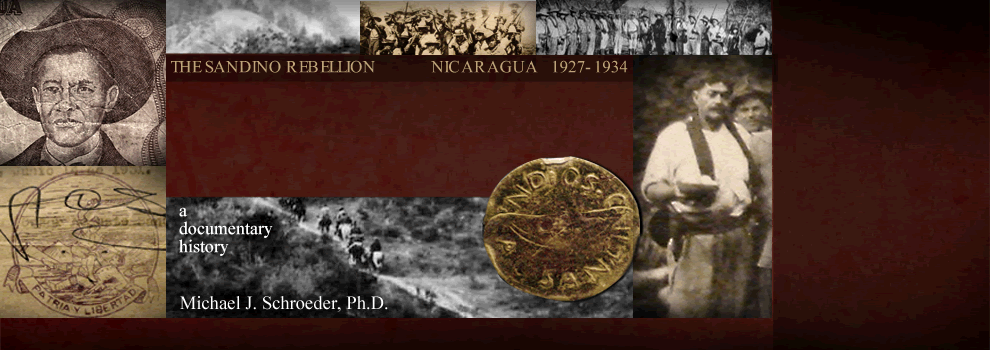|
27.09.22.
SKETCH MAP OF THE COMBAT IN TELPANECA
||
BOSQUEJO CARTOGRÁFICO DEL
COMBATE DE TELPANECA
|
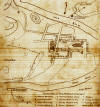
Click on thumbnail above
for enhanced large-scale
image (200 dpi).
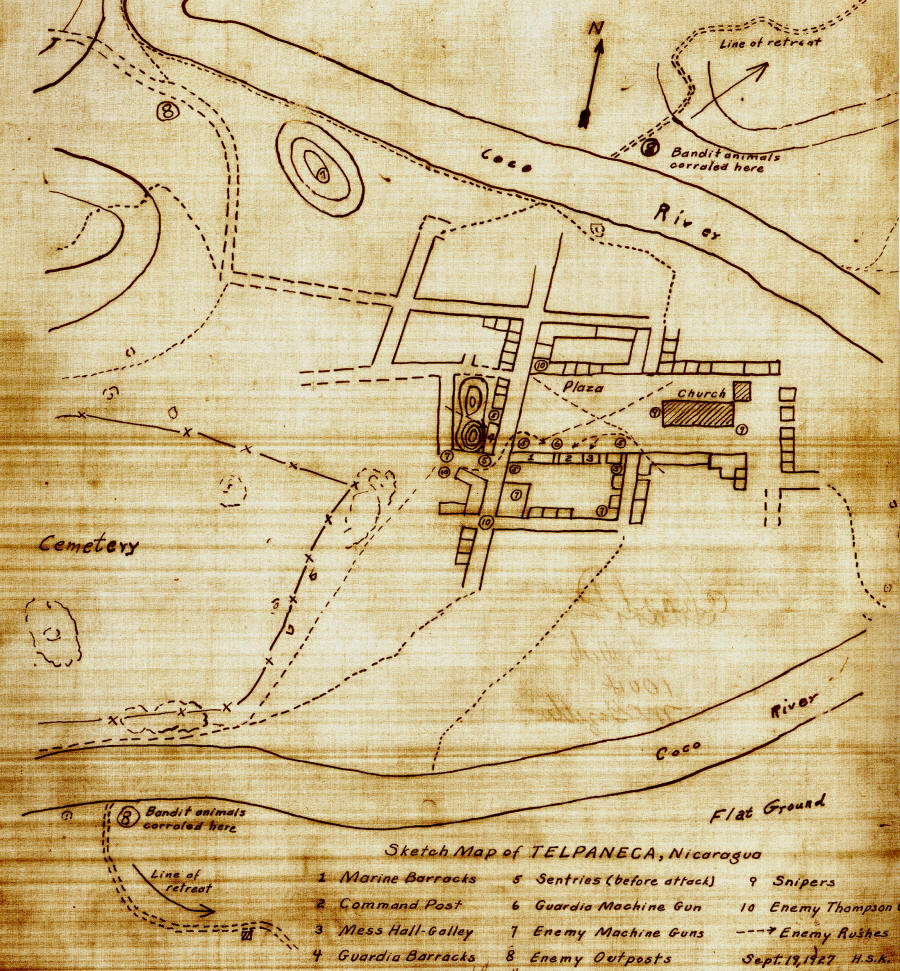
Map of events of 19
September 1927 by USMC
First Lt. and GNN
Captain H.S. Keimling.
Source: Record
Group 127, Entry 38, Box
30 (RG127/38/30), U.S.
National Archives &
Records Administration
(NARA), 700 Pennsylvania
Ave NW, Washington,
D.C., 20408.
|
Document Inventory
||
INVENTARIO DE DOCUMENTOS
27.09.19. BRIEF SYNOPSIS
OF BATTLE OF TELPANECA
(EN ESPAÑOL)
|
T R A N S C R I
P T I O N •
T R A N S C R I P C I Ó
N
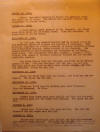 SEPTEMBER
19, 1927: SEPTEMBER
19, 1927:
At 1.00 a.m. two hundred
bandits led by Salgado
attacked the combined
forces of Marines and
Guardia at Telpaneca.
This garrison consisted
of a total strength of
twenty enlisted Marines
and twenty-five Guardia,
under command of Lt.
Keimling. The
battle started at close
quarters and continued
so far about four hours.
The casualties wer Pvt.
Lenton C. Russell,
USMC., killed, Pvt.
James S. Glasser,
mortally wounded and one
Guardia seriously
wounded.
|
Document Inventory
||
INVENTARIO DE DOCUMENTOS
27.09.19. BREVE
SINOPSIS DE LA BATALLA DE
TELPANECA
|
T R A N S C R I
P T I O N •
T R A N S C R I P C I Ó
N
19 de Septiembre de
1927.
A las 1.00 de la
madrugada doscientos
bandoleros dirigidos por
Salgado atacaron las
fuerzas combinadas de
Marines y Guardia en
Telpaneca. Esta
guarnición consistía en
una fuerza total de
veinte soldados y
veinticinco guardias,
bajo el mando del
teniente Keimling. La
batalla comenzó de poca
proximidad y continuó
hasta ahora unas cuatro
horas. Las víctimas
fueron Pvt. Lenton C.
Russell, USMC., matado,
Pvt. James S. Glasser,
herido mortalmente y un
Guardia gravemente
herido.
.
|
Document Inventory
||
INVENTARIO DE DOCUMENTOS
27.09.22.
CAPTAIN PEARD'S REPORT ON THE TELPANECA
ATTACK
(EN ESPAÑOL)
|
T R A N S C R I
P T I O N •
T R A N S C R I P C I Ó
N
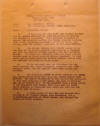 OFFICE OF THE COMMANDING
OFFICER OFFICE OF THE COMMANDING
OFFICER
PUEBLO NUEVO, NIC.
22 Sept. 1927.
|
From: |
The Commanding Officer. |
|
To: |
The Commanding Officer, Fifth
Regiment. |
|
Subject: |
Telpaneca Attack. |
1. At 1:00 a.m., 19 Sept., 1927, two hundred
bandits led by Salgado
attacked the combined
forces of Marines and
Guardia at Telpaneca.
This garrison consisted
of twenty five enlisted
Guardia and twenty
enlisted Marines, with
First Lieutenant
Keimling, U.S. Marine
Corps, now on duty with
the Guardia Nacional, as
the only officer.
2. The attack started by a bandit coming into the
door of the Marines
quarters and emptying a
Thompson gun into the
bunk of Private Russell,
who was instantly
killed. The night was
extremely dark and foggy
and the bandits were at
close quarters before
observed. In fact there
was no alarm until the
bandits started firing
into the barracks
buildings at close
range.
3. It is believed that the attackers had one
Lewis machine gun, three
Thompsons, numerous
home-made dynamite
bombs, and the balanced
armed with rifles and
machetes.
4. The fighting lasted at close quarters for
about four hours and at
5:00 a.m., the bandit
bugler blew retreat. The
battle discipline of the
bandits was excellent in
that they attacked in
two ways, one wave of
riflemen and one of
machete men. It is
apparent that a large
number of the attackers
were drunk, this
accounted for their
close fighting or
otherwise they would not
have had the nerve to
come in close.
5. A large number of the dead and wounded were
removed by the bandits
before they retreated,
but a conservative
estimate of their losses
was twenty-five killed
and fifty wounded.
[p. 2]
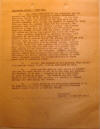 6. The
first objective of the
attackers was the
Guardia and this newly
organized Guardia
Detachment acquitted
itself in an excellent
manner. At one time
during the fight, the
bandits at the rear wall
of the guardia barracks
tried to get the guardia
to desert to their side
and help the bandits
clean out the Marines;
the guardia's only
answer was another
volley. One guardia
picked up a bomb that
was thrown in the
guardia compound, heaved
it over the fence,
stepped around the
corner and killed the
bandit who threw the
bomb. One other guardia
disguised in civilian
clothes, left Telpaneca
at about five a.m., and
brought to Pueblo Nuevo
the first news we had of
the attack; he arrived
here at 1:00 p.m., 19
September, and at 2:00
p.m., insisted on
returning to Telpaneca
with my relief. Enroute
to Pueblo Nuevo this
same Guardia brought
five Guardia mules about
half way and left them
in a portrero [potrero,
pasture] for safe
keeping so the bandits
would not get them, then
walked the balance of
the distance. Another
Guardia carried orders
from Keimling from
building to building
throughout the entire
battle exposing himself
to the enemy fire.
Separate reports and
recommendations in these
cases will be submitted
later.
6. The
first objective of the
attackers was the
Guardia and this newly
organized Guardia
Detachment acquitted
itself in an excellent
manner. At one time
during the fight, the
bandits at the rear wall
of the guardia barracks
tried to get the guardia
to desert to their side
and help the bandits
clean out the Marines;
the guardia's only
answer was another
volley. One guardia
picked up a bomb that
was thrown in the
guardia compound, heaved
it over the fence,
stepped around the
corner and killed the
bandit who threw the
bomb. One other guardia
disguised in civilian
clothes, left Telpaneca
at about five a.m., and
brought to Pueblo Nuevo
the first news we had of
the attack; he arrived
here at 1:00 p.m., 19
September, and at 2:00
p.m., insisted on
returning to Telpaneca
with my relief. Enroute
to Pueblo Nuevo this
same Guardia brought
five Guardia mules about
half way and left them
in a portrero [potrero,
pasture] for safe
keeping so the bandits
would not get them, then
walked the balance of
the distance. Another
Guardia carried orders
from Keimling from
building to building
throughout the entire
battle exposing himself
to the enemy fire.
Separate reports and
recommendations in these
cases will be submitted
later.
7. As for the conduct of the Marines, they fought
like Marines always
fight, nothing more need
be said.
8. Five Guardia animals were killed by bandits
and have no exact
[information] yet as to
how many are missing;
the portrero [potrero]
is in such a location as
to be impossible to
guard during an attack.
The bandits cut the wire
fence of the pasture
thus allowing the
animals to wander
through the town during
the battle.
9. Lieut. Keimling and the entire garrison is to
be commended for their
courageous and effective
defense against large
odds and a surprise
attack.
R. W. PEARD
- - - - - - - - - - - -
Capt., USMC - - - - - -
-
NA127/212/1 and 113C/12
|
Document Inventory
||
INVENTARIO DE DOCUMENTOS
27.09.22.
REPORTE DEL CAPITAN PEARD DEL
ATAQUE DE TELPANECA
|
T R A N S C R I
P T I O N •
T R A N S C R I P C I Ó
N
OFICINA DEL OFICIAL AL
MANDO
PUEBLO NUEVO, NIC.
22 SEPTIEMBRE 1927
|
De: |
El Comandante. |
|
A: |
El Comandante del Quinto
Regimiento. |
|
Tema: |
Ataque de Telpaneca. |
1. A las 1:00 de la mañana, 19 de
septiembre de 1927,
doscientos bandoleros
dirigidos por Salgado
atacaron las fuerzas
combinadas de Marines y
Guardias en Telpaneca.
Este regimiento constaba
de veinticinco Guardias
enlistados y veinte
soldados de la Marina
reclutados, con el
teniente primero
Keimling, del Cuerpos de
la Marina de los Estados
Unidos, ahora en
servicio con la Guardia
Nacional, como el único
oficial.
2. El ataque comenzó cuando un bandido
entró en la puerta de
los cuarteles de los
Marines y disparo un
cañón Thompson en la
litera del soldado
Russell, quien fue
asesinado
instantáneamente. La
noche era extremadamente
oscura y brumosa, y los
bandidos estaban a poca
distancia. De hecho, no
hubo alarma hasta que
los bandidos comenzaron
a disparar contra los
edificios del cuartel a
corta distancia.
3. Se cree que los atacantes tenían una
ametralladora Lewis,
tres Thompsons,
numerosas bombas de mano
de dinamita hechas en
casa (hechizas) y
hombres armados con
rifles y machetes.
4. La lucha frente a frente duró por cuatro
horas, y ya las cinco de
la mañana, el clarinero
de los bandidos tocó la
retirada. La disciplina
de batalla de los
bandidos fue excelente
dado que atacaron de dos
maneras, un grupo de
fusileros y uno, con
hombres con machetes. Es
evidente que un gran
número de los atacantes
estaban borrachos, esto
explicaba su lucha
cercana o de otra manera
no tendrían el valor de
acercarse.
5. Un gran número de muertos y heridos
fueron removidos por los
bandidos antes de
retirarse, pero una
estimación conservadora
de sus pérdidas fue de
veinticinco muertos y
cincuenta heridos.
6. El primer objetivo de los atacantes fue
la Guardia, y este
recientemente organizado
Destacamento de la
Guardia se excusó de una
manera excelente. En una
ocasión durante la
lucha, los bandidos- en
la pared trasera del
cuartel de la guardia-
intentaron conseguir que
la guardia desertara a
su favor, y ayudar a los
bandidos a deshacerse de
los infantes de la
Marina; La única
respuesta de la guardia
fue otro disparo. Un
hombre de la guardia
recogió una bomba que
fue lanzada en el
complejo de la guardia,
la colocó sobre la
valla, dio un paso en la
esquina y mató a los
bandidos que lanzaron la
bomba. Otro guardia
disfrazado de civil,
salió de Telpaneca a las
cinco de la mañana y
llevo a Pueblo Nuevo las
primeras noticias que
teníamos del ataque; él
llegó a las 1:00 a.m.
del 19 de septiembre, y
a las 02:00p.m. insistió
en regresar a Telpaneca
con ayuda. En el camino
a Pueblo Nuevo, este
mismo de la Guardia
trajo a cinco mulas de
la Guardia a mitad de
camino y las dejó en un
potrero (potrero o la
caballeriza) para
guardarlas de forma
segura de modo que los
bandidos no las
obtuvieran, luego caminó
el resto de la
distancia. Otro Guardia
llevó órdenes de
Keimling desde un
edificio a otro edificio
durante toda la batalla
exponiéndose al fuego
enemigo. Informes y
recomendaciones de estos
casos serán
proporcionados por
separado. [pág. 2]
7. En cuanto a la conducta de los infantes
de la Marina, lucharon
como los infantes de
Marina siempre luchan,
no hay más que decir.
8. Cinco animales de la Guardia fueron
asesinados por los
bandidos y aún no hay
exactitud [información]
sobre cuántos están
desaparecidos; El
potrero [potrero] se
encuentra en un lugar
tal que es imposible
vigilar durante un
ataque. Los bandidos
cortaron los cables de
la valla del pastizal,
permitiendo así a los
animales deambular por
la ciudad durante la
batalla.
9. Teniente Keimling y toda la guarnición
debe ser elogiado por su
defensa valiente y
eficaz contra gran
disparidad, (y) de un
ataque sorpresa.
R. W. Peard
- - - - - - - - - - - -
Capt., USMC - - - - - -
-
All Marine-Guardia
reports on this page are
housed in Record Group
127, Entry 212, Box 1,
and RG127, Entry 113C,
Box 12, US National
Archives, Washington
D.C.
|
Document Inventory
||
INVENTARIO DE DOCUMENTOS
27.09.22.
FIRST LIEUTENANT HERBERT S. KEIMLING,
STATEMENT OF THE
BATTLE OF TELPANECA
(EN ESPAÑOL)
|
T R A N S C R I
P T I O N •
T R A N S C R I P C I Ó
N
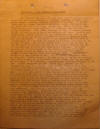 FIRST LIEUTENANT HERBERT S.
KEIMLING FIRST LIEUTENANT HERBERT S.
KEIMLING
STATEMENT OF THE BATTLE
OF TELPANECA
At or about one a.m.,
19 Sept 1927, Bandit
groups numbering about
200 under the command of
Colindre [Juan Gregorio
Colindres], Estrada
[Francisco Estrada],
Salgado [Carlos
Salgado], Diaz [José
León Díaz], Tomas Migado
[Tómas Melgara?],
Sanchez [Porfirio
Sánchez], Rameriz
[Ramírez], attacked
Telpaneca. Town was
blanketed by a heavy fog
which permeated through
the buildings. Sky dark
over cast with heavy
thundering. Battle
stations were taken
immediately after
explosion of dynamite
bomb in rear of Marine
quarters. Pvt. Irwin
sentinel in rear of
Marine Quarters killed
the bandit as he ran
after setting off bomb.
Bandits laid heavy
rifle, Lewis Machine gun
and subthompson gun fire
on the rear of marine
and Guardia Quarters
followed by dynamite
bombs and hand grenades.
The front of the
Quarters was peppered by
sub-thompson fire
followed by rushes by
riflemen with machete
men in rear of them. Two
groups rushed right up
to the doorway of the
small buildings occupied
by the cooks & messman
and the office building
in which the undersigned
resided. As I was
rushing out of the
doorway of the office
building which was
designated during the
attack as the Command
Post Sgt Eadens shoved
me back saying "Here
they come" and shot the
bandit whose rifle was
pointed at me. As the
bandit staggered back he
shot Pvt. Glaser
U.S.M.C., who was going
to his battle station.
Pvt. Irwin coming up in
the rear of Pvt. Glaser
shot up the rest of the
group of the bandits.
Sub-thompson fire was
directed on us. Pvt.
Glaser staggered as Sgt.
Eaden and I grabbed him
and dragged him into the
office. Pvt. Glaser
received some more
bullet wounds while we
dragged him in. Sgt.
Eaden and I worked in
reliefs guarding the
door and bandaging and
attending the wounded
man. I told Sgt. Eaden
to take charge & guard
the front as I was going
to give some information
to my Marines and
Guardias. I first
ordered them to fire
faster, appointed men in
different parts of the
Marine and Guardia
Quarters to take command
in my absence & to let
the men fire as fast as
possible for ten minutes
and then to fire at
flashes caused by their
rifle fire and to
impress on the men to
aim and conserve their
ammunition. After the
first fifteen minutes
everybody settled down
and shot like veterans.
The Marines & Guardias
had excellent fire
control and discipline.
Directed Pvt. Macon the
Lewis Machine Gunner to
use traversing fire
across the plaza. While
I was along side of Pvt.
Morris he said "Look at
the bozo coming down the
hill, skipper". We
watched the Bandit throw
something in the Guardia
Quarters & next instant
it was thrown out by
Raso Salamanca who then
shot the bandit. Another
form was seen moving
down the hill but no
Marines fired as they
each had their own
sector and would have
fired into the Guardia
Quarters. Raso Cuena GNN
got mad at all the bombs
exploding around his
battle station so he
proceeded to leave the
building under heavy
fire and shot the next
bomb thrower coming down
the hill receiving a
slug in his foot in
return. The bandit kept
going towards the Lewis
Machine Gun emplacement
to drop his bomb when
Pvt.
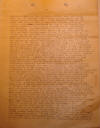 [ p. 2 ] Morris hollered
out "Who is that a
Guardia." Raso Luis
Huerta said, "No, una
bandito". Pvt. Morris
let him have it and the
machine gunner finished
him. I was recalled to
the Command Post. Got
their [there] in time to
throw some grenades at a
group making a rush
under fire toward the
rear of the Command
Post. Several bandits
groups fired by commands
and did some pretty good
shooting. Word was
passed to me that the
Lewis Machine gun was
jammed. Before I could
say a word Sgt. Eaden
gave me his rifle and
said "Captain guard the
door I'll fix it" and he
did out in the open
under fire without any
shelter. The machine
gunner grabbed his own
rifle firing rapid fire
trying to initiate a
Lewis. Then some of the
subtompsons gave a
little trouble, Sgt.
Eaden went around and
swabbed them out each
half hour when I would
pass the hour of the
morning. No trouble
after that. Fog started
to raise at about 2:30
a.m., and get lighter
about 4 a.m., Everything
was all quiet at 5 a.m.
Investigation & search
of the town showed that
a subthompson was
operated from the plaza
in front of marine
Quarters, one from
south-east side of
church, two from either
side of street corners
sough and toward rear of
Guardia and Marine
Quarters another was
operated on a slight
rise toward the
south-west of Guardia
Quarters. I passed the
word whenever possible
to jump a subthompson if
close enough. Acting
Cpl. Justo Salamanca,
Rasos Luis Huerto, Luis
Sanchez and Salomon
Cortes jumped a
subthompson operating
against their quarters
but had to withdraw when
a group attacked them
with hand grenades. They
accomplished their
mission as the thompson
was withdrawn from that
sector. Undersigned
believes that the
bandits had 3
subthompsons and moved
them from one sector to
another. One Lewis was
operated near a building
south of Marine and
Guardia Quarters.
Another was operated
from hill on the main
road 300 yds from the
town (NW). Bandits had
about 140 men in the
main attack on the
Quarters of the
Detachment. Other groups
were posted on all the
roads and trails leading
into town. A general
reserve was with all
their animals on the
other side of the Rio
Coco South East of 40.
The enemy started to
withdraw their dead and
wounded about 3 a.m. The
enemy's riflemen went
into battle with about
50 rds of amm apiece.
Enemies general line of
retreat was from the
Northeast and Southeast
of 40. Houses were
searched and a number of
dynamite bombs and hand
grenades found. Average
dynamite bomb had from
24 to 26 sticks of
dynamite. All enemies
munitions and explosives
thrown into the Rio
Coco. Two dynamite bombs
were thrown thru the
roof in rear of Guardia
Quarters. Raso Pedro
Saballos threw one of
the bombs out of the
building receiving
wounds to his hand from
the explosion of same.
An unknown Guardia threw
out the other. So the
bandits would not hear
my commands to the
Guardia's I passed the
word for Raso Luis
Huerta to report to C.P.
He did under heavy fire.
I sent Raso Huerta
several times with
verbal messages to my
Guardias. He always came
back with a smile. I
then posted him to guard
the front of the C.P and
look after the wounded
marine till I came.
Found everybody at the
post and in the best of
spirits, passing jokes
and firing at
[ p. 2 ] Morris hollered
out "Who is that a
Guardia." Raso Luis
Huerta said, "No, una
bandito". Pvt. Morris
let him have it and the
machine gunner finished
him. I was recalled to
the Command Post. Got
their [there] in time to
throw some grenades at a
group making a rush
under fire toward the
rear of the Command
Post. Several bandits
groups fired by commands
and did some pretty good
shooting. Word was
passed to me that the
Lewis Machine gun was
jammed. Before I could
say a word Sgt. Eaden
gave me his rifle and
said "Captain guard the
door I'll fix it" and he
did out in the open
under fire without any
shelter. The machine
gunner grabbed his own
rifle firing rapid fire
trying to initiate a
Lewis. Then some of the
subtompsons gave a
little trouble, Sgt.
Eaden went around and
swabbed them out each
half hour when I would
pass the hour of the
morning. No trouble
after that. Fog started
to raise at about 2:30
a.m., and get lighter
about 4 a.m., Everything
was all quiet at 5 a.m.
Investigation & search
of the town showed that
a subthompson was
operated from the plaza
in front of marine
Quarters, one from
south-east side of
church, two from either
side of street corners
sough and toward rear of
Guardia and Marine
Quarters another was
operated on a slight
rise toward the
south-west of Guardia
Quarters. I passed the
word whenever possible
to jump a subthompson if
close enough. Acting
Cpl. Justo Salamanca,
Rasos Luis Huerto, Luis
Sanchez and Salomon
Cortes jumped a
subthompson operating
against their quarters
but had to withdraw when
a group attacked them
with hand grenades. They
accomplished their
mission as the thompson
was withdrawn from that
sector. Undersigned
believes that the
bandits had 3
subthompsons and moved
them from one sector to
another. One Lewis was
operated near a building
south of Marine and
Guardia Quarters.
Another was operated
from hill on the main
road 300 yds from the
town (NW). Bandits had
about 140 men in the
main attack on the
Quarters of the
Detachment. Other groups
were posted on all the
roads and trails leading
into town. A general
reserve was with all
their animals on the
other side of the Rio
Coco South East of 40.
The enemy started to
withdraw their dead and
wounded about 3 a.m. The
enemy's riflemen went
into battle with about
50 rds of amm apiece.
Enemies general line of
retreat was from the
Northeast and Southeast
of 40. Houses were
searched and a number of
dynamite bombs and hand
grenades found. Average
dynamite bomb had from
24 to 26 sticks of
dynamite. All enemies
munitions and explosives
thrown into the Rio
Coco. Two dynamite bombs
were thrown thru the
roof in rear of Guardia
Quarters. Raso Pedro
Saballos threw one of
the bombs out of the
building receiving
wounds to his hand from
the explosion of same.
An unknown Guardia threw
out the other. So the
bandits would not hear
my commands to the
Guardia's I passed the
word for Raso Luis
Huerta to report to C.P.
He did under heavy fire.
I sent Raso Huerta
several times with
verbal messages to my
Guardias. He always came
back with a smile. I
then posted him to guard
the front of the C.P and
look after the wounded
marine till I came.
Found everybody at the
post and in the best of
spirits, passing jokes
and firing at
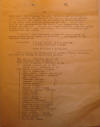 [ p. 3 ] the enemy's
rifle flashes. Told Pvt.
Morris to get an
automatic rifle and
clean up the outside of
the rear of the Marine
Quarters as I suspected
some bandits who had
sneaked up in the
beginning of the attack
were there and could not
get away. Out of the
door he went unconcerned
to the enemies fire,
accomplished his mission
and returned. Over the
the Guardia Quarters I
saw Raso Rafael Romero
(cook) while under fire
keeping the Guardia
Detachment well supplied
with hot coffee.
[ p. 3 ] the enemy's
rifle flashes. Told Pvt.
Morris to get an
automatic rifle and
clean up the outside of
the rear of the Marine
Quarters as I suspected
some bandits who had
sneaked up in the
beginning of the attack
were there and could not
get away. Out of the
door he went unconcerned
to the enemies fire,
accomplished his mission
and returned. Over the
the Guardia Quarters I
saw Raso Rafael Romero
(cook) while under fire
keeping the Guardia
Detachment well supplied
with hot coffee.
I believe I have overlooked a number of heroic deeds and cannot
express myself enough to
do justice to the
bravery of the Telpaneca
Detachment.
Casualties 1 Marine killed 1 died same day
1 Guardia seriously wounded.
Enemy 25 killed & 50 wounded.
The following are recommended for Guardia Medals, promotion and
cited for bravery in
battle with bandits.
Cpl. Jose A. Hernandez,
pro to Sgt
Cabo Francisco Pena,
citation
Raso Justo Salamanca -
Medal- pro to Sgt
"
Modesto Morales - pro to
Cpl
"
Huerta Luis - Medal -
Pro to Sgt
Raso Carlos Aguirres -
citation
" Juan
T. Altamirano - "
"
Pedro Ardon - Medal -
pro to Cpl
"
Francisco Arguello -
citation
" Adan
Centeno -
"
"
Francisco Canales -
"
"
Hernesto Centillo -
"
"
Alberto Cheves -
"
"
Alberto Centeno
"
"
Salomon Cortes - Medal
"
Marcos A. Celedon -
Citation
"
Diego Condega -
"
"
Miguel Jeres -
"
"
Octavio Mejia -
"
"
Ofilio Medina -
"
"
Alejandro Rodriguez -
"
"
Rafael Romero - Citation
"
Napoleon Reyes -
Citation
"
Pedro Saballos - Medal
"
Miguel Santamaria -
Citation
"
Julio Tapia
"
" Luis
Sanchez Medal
"
Domingo Sapata [Zapata]
- Citation
"
Miguel Savala [Zavala]
"
" F.
A. Acuna - Medal
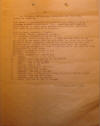 [p.
4] The following
Marines are recommended
for promotion, medals or
citation: [p.
4] The following
Marines are recommended
for promotion, medals or
citation:
Sgt. Eaden, A.
recommended for
Congressional Medal of
Honor, - rescuing
wounded Marine under
fire - repairing Lewis
machine while exposed to
enemy fire, bravery
during battle.
Recommend Sgt. Eaden be
promoted to Gy [Gunnery]
Sergeant.
Cpl. Carlson, Frederick
- citation
Pvt. Foote, George -
promoted to Cpl.
[Corporal]
Pvt. Grubbs - Citation
pro to 1st cl pvt
[promotion to Private
First Class]
Pvt. Glaser, James
Stephen while mortally
wounded tried to use his
rifle on the enemy with
one hand after the other
was shattered by bullet
wound, staggered towards
his battle station with
grim determination.
When he heard a
subthompson jammed and
he was lying mortally
wounded on a bunk Glaser
requested his rifle be
used. Recommended
for Navy Cross.
Handzlik, Laurence C. -
pro to Cpl [promotion to
corporal]
Huelsman, Citation
Pvt. Irwin, Rodgers H. -
pro to Cpl
"
Isdell
" "
"
"
Luarie - citation, pro
to 1st cl private
"
Macon - D.E. - pro to
Cpl
" Mark
- pro to 1st cl pvt
"
Morris - pro to Cpl
"
Mechura, Jeremiah J.
*--------
"
Nichols, F. L. Pro to
Cpl
"
Ruddock - pro 1st Cl
private
"
Russell L.C. - Navy
Cross (killed in Action)
See my letter
"
Shepard - pro 1st cl
Private
"
Warnack - pro 1st cl
private
"
Marsh, H.E. Pro to 1st
Cl private
H.S. Keimling Capt.
G.N.N.
RG127/113C/12
|
Document Inventory
||
INVENTARIO DE DOCUMENTOS
27.09.22.
PRIMER TENIENTE H. S. KEIMLING,
DECLARACIONES SOBRE LA BATALLA
DE TELPANECA
|
T R A N S C R I
P T I O N •
T R A N S C R I P C I Ó
N
PRIMER TENIENTE H. S.
KEIMLING
DECLARACIONES SOBRE LA
BATALLA DE TELPANECA
Alrededor de la una de
la mañana, del 19 de
septiembre de 1927, un
grupo de bandido, de
alrededor de 200, bajo
el mando de Colindre
[Juan Gregorio
Colindres], Estrada
[Francisco Estrada],
Salgado [Carlos
Salgado], Díaz [José
León Díaz], Tomas Migado
[Tomas Melgara], Sánchez
[Porfirio Sánchez],
Rameriz [Ramírez], atacó
a Telpaneca. El pueblo
estaba cubierto por una
niebla espesa que
penetraba a través de
las edificaciones. Con
el cielo oscuro sobre el
reparto con fuertes
truenos. Las estaciones
de batalla fueron
tomadas inmediatamente
después de la explosión
de la bomba de dinamita
en la parte trasera de
los cuarteles de la
Marina. El Cabo Irwin,
centinela en la parte
trasera del cuartel de
los Marines mató al
bandido mientras corría
después de lanzar una
bomba. Los bandidos
tenían rifles pesados,
ametralladoras Lewis y
armas de fuego
sub-thompson en la parte
posterior de los cuartos
de los Marinos y de la
Guardia, seguidos por
bombas de dinamita y
granadas de mano. El
frente de los cuartos
fue acribillado por
fuego de las armas
sub-thompson seguido por
ráfagas de rifle, y con
hombres con machetes en
la parte posterior de
ellos. Dos grupos se
apresuraron directamente
a la puerta de los
pequeños edificios
ocupados por los
cocineros y camarero, y
el edificio de las
oficinas en el que el
infrascrito residía.
Mientras yo me
apresuraba para correr a
la puerta del edificio,
el cual fue designado
durante el ataque como
el Puesto de Comando, el
Sargento Eadens me
empujó diciendo "Aquí
vienen" y disparó al
bandido cuyo rifle me
apuntaba. Mientras el
bandido retrocedía, él
disparó al Cabo Glaser,
Cuerpo de marina de EEUU
(USMC), que iba a su
estación de batalla. El
Cabo Irwin quien venía
por la parte trasera del
Cabo Glaser disparó al
resto del grupo de los
bandidos. Fuego de arma
de la Sub-thompson fue
dirigido hacia nosotros.
El Cabo Glaser se
tambaleó mientras el
Sargento Eaden y yo lo
agarramos y lo
arrastrábamos hasta la
oficina. El Cabo Glaser
recibió más heridas de
bala mientras lo
arrastrábamos. El
Sargento Eaden y yo
trabajábamos en asistir
la vigilancia de la
puerta y vendando y
atendiendo al herido. Le
dije al sargento Eaden
que tomara el mando y
custodiara el frente
mientras iba a darle
información a los
Marines y Guardias.
Primero ordené que
dispararan con más
rapidez, nombré a
hombres en diferentes
partes del Cuartel de la
Marina para tomar el
mando en mí ausencia y
dejar que los hombres
dispararan lo más rápido
posible durante diez
minutos, y luego
disparar contra los
destellos causados por
sus rifles (de los
bandidos) y para motivar
a los hombres para
dirigir y conservar sus
municiones. Después de
los primeros quince
minutos todo el mundo se
estabilizó y dispararon
como veteranos. Los
Marines y Guardias
tuvieron excelente
control del fuego y
disciplina. Ordene al
Cabo Macon la
ametralladora Lewis para
utilizar fuego
transversal a lo largo
de la plaza. Mientras yo
estaba al costado del
Cabo Morris dijo: "Mire
el “bozo” bajando la
colina, capitán".
Nosotros vimos a los
bandidos lanzar algo en
el cuartel de la Guardia
y al instante siguiente
fue lanzado fuera por el
Raso Salamanca quien
luego disparó a los
bandidos. Otra forma se
observó moviéndose de
bajada a la colina, pero
ningún de los Marines
disparó, ya que cada uno
tenía su propio sector y
habría disparado a los
Cuarteles de la Guardia.
El Raso Cuena, GN se
enojó con todas las
bombas que explotaron
alrededor de su estación
de batalla, así que
procedió a abandonar el
edificio bajo fuego
pesado y disparó al
siguiente lanzador de
bombas que venía colina
abajo, recibiendo una
bala en su pie a cambio.
Los bandidos siguieron
avanzando con el
desplazamiento de la
ametralladora Lewis para
lanzar sus bombas cuando
el Cabo
[ pag. 2] Morris gritó
"¿Quién es? Un
Guardia?". Raso Luis
Huerta dijo: "No, una
bandito (bandido)". El
cabo Morris lo dejó
tomarlo y el
ametrallador terminó
con. Fui llamado al
puesto de mando. Llegue
[allí] a tiempo para
lanzar algunas granadas
a un grupo haciendo una
carrera bajo el fuego
dirigido a la parte
posterior del puesto de
comando. Varios grupos
de bandidos dispararon
bajo orden e hicieron
algunos muy buenos
disparos. Fui informado
que la ametralladora
Lewis estaba atascada.
Antes de que pudiera
decir una palabra, el
sargento Eaden me dio su
rifle y dijo: "Capitán,
guarde la puerta, yo la
arreglaré" y lo hizo a
la intemperie bajo
fuego, sin refugio
alguno. El artillero
agarró su propio rifle
disparando fuego rápido
tratando de iniciar la
ametralladora Lewis.
Entonces algunas de las
subtompsons empezaron a
dar un poco de problema,
el Sargento Eaden iba y
las despejaba cada media
hora hasta llegar la
mañana. No hubo
problemas después de
eso. La niebla empezó a
subir a las 2:30 am y se
puso más ligera
alrededor de las 4 de la
mañana. Todo estaba en
silencio a las 5 de la
mañana. Investigaciones
y búsquedas en la ciudad
demostraron que una
subtompsons se operaba
desde la plaza frente al
Cuartel de la marina,
una del lado este de la
iglesia, dos desde cada
lado de las esquinas de
las calles y hacia la
parte posterior de la
Guardia y Cuartel de los
Marines, otra fue
operada en una subida
ligera hacia el suroeste
del cuartel de la
Guardia. Pasé la palabra
siempre que era posible
saltar un subthompson si
estaba lo
suficientemente cerca.
Actuando el Cabo Justo
Salamanca, Rasos Luis
Huerto, Luis Sánchez y
Salomón Cortés saltaron
la subthompson que
operaba contra su
cuartel pero tuvieron
que retirarse cuando un
grupo los atacó con
granadas de mano. Ellos
cumplieron su misión
cuando la thompson fue
retirada de ese sector.
El infrascrito cree que
los bandidos tenían 3
subthompsons y las
movieron de un sector a
otro. Una Lewis fue
operada cerca de un
edificio al sur de la
Marina y el cuartel de
la Guardia. Otra fue
operada desde la colina
en la carretera
principal a 300 yardas
de la ciudad (de Norte a
Oeste). Los bandidos
tenían alrededor de 140
hombres en el ataque
principal contra los
Cuarteles del
Destacamento. Otros
grupos fueron colocados
en todas las carreteras
y senderos que conducen
a la ciudad. Una reserva
general estaba con todos
sus animales en el otro
lado del Río Coco
Sureste de 40. El
enemigo comenzó a
retirar a sus muertos y
heridos alrededor de las
3 de la madrugada. Los
hombres encargados de
los rifles (fusileros)
de los enemigos entraron
a la batalla con cerca
de 50 cartuchos de
amuniciones por pieza.
Las líneas generales de
retirada de los enemigos
eran desde el noreste y
el sureste de 40. Se
registraron casas y se
encontraron varias
bombas de dinamita y
granadas de mano. El
rango de dinamita de las
bombas era entre de 24 a
26 cartuchos de
dinamita. Todas las
municiones y explosivos
de los enemigos
arrojados en el Río
Coco. Dos bombas de
dinamita fueron lanzadas
sobre del techo en la
parte trasera del
cuartel de la Guardia.
El Raso Pedro Saballos
tiró una de las bombas
del edificio recibiendo
heridas en su mano de la
explosión de la misma.
Un Guardia desconocido
lanzó la otra para que
los bandidos no
escucharían mis órdenes
a la Guardia. Pasé la
palabra al Raso Luis
Huerta para que
informará al Puesto de
comando. Lo cual hizo
bajo fuego intenso.
Envié a Raso Huerta
varias veces con
mensajes verbales a mis
Guardias. Siempre
regresaba con una
sonrisa. Entonces lo
puse a cargo de vigilar
el frente del Puesto de
comando y cuidar a los
marinos heridos hasta
que llegara. Encontré a
todos en el puesto y en
el mejor de los
espíritus, haciendo
bromas y disparando a
las chispas de los
disparos de los
enemigos. [Página 3] Le
dije al cabo Morris que
tomara un rifle y
despejara las afueras de
la parte trasera del
cuartel de la Marina
debido a mis sospechas
de que algunos bandidos
se habían filtrado desde
el comienzo del ataque y
podrían estar ahí y no
habrían podido salir de
ahí. Fuera de la puerta,
este partió sin estar
apercibido del fuego
enemigo, completo su
misión y regreso. En el
cuartel de la guardia
mire al raso Rafael
Romero (el cocinero)
quien mientras estaba el
fuego abierto mantenía
al destacamento de la
guardia bien provisto
con café caliente.
Creo que he pasado por alto una serie de hechos heroicos y no
puedo expresarme lo
suficiente como para
hacer justicia a la
valentía del
Destacamento de
Telpaneca.
Víctimas
1 Marino muerto 1 muerto
el mismo día
1 Guardia herido gravemente.
Enemigo 25 muertos y 50 heridos.
Los siguientes son
recomendados para
Medallas de La Guardia,
promocionados y citados
por valentía en la
batalla con bandoleros.
Cabo José A. Hernández,
promoción a Sargento
Cabo Francisco Pena,
citación
Raso Justo Salamanca –
Medalla. Promoción a
Sargento
" Modesto Morales – Promoción a Cabo
" Huerta Luis - Medalla – Promoción a Sargento
" Carlos Aguirres – citación
" Juan T. Altamirano - " (citación)
" Pedro Ardon - Medalla – promoción a Cabo
" Francisco Arguello – citación
" Adan Centeno - " (citación)
" Francisco Canales - " (Citación)
" Hernesto Centillo - " (Citación)
" Alberto Cheves - " (Citación)
" Alberto Centeno – " (Citación)
" Salomón Cortés - Medalla
" Marcos A. Celedón - Citación
" Diego Condega - " (Citación)
" Miguel Jeres - "(Citación)
" Octavio Mejía - (Citación)
" Ofilio Medina - " (Citación)
" Alejandro Rodríguez - " (Citación)
" Rafael Romero - Citación
" Napoleón Reyes - Citación
" Pedro Saballos - Medalla
" Miguel Santamaría - (Citación)
" Julio Tapia - " (Citación)
" Luis Sánchez - Medalla
" Domingo Sapata [Zapata] - Cita
" Miguel Savala [Zavala] - " (Citación)
" F. A. Acuna - Medalla
[p. 4 - . . . en
preparación . . . ]
H.S. Keimling Capt.
G.N.N.
RG127/113C/12
|
Document Inventory
||
INVENTARIO DE DOCUMENTOS
27.09.22. STATEMENT OF SGT. ALVA
EADENS
(EN ESPAÑOL)
|
T R A N S C R I
P T I O N •
T R A N S C R I P C I Ó
N
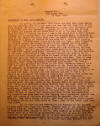 Marine Det. Marine Det.
Telpaneca, Nic.
22 Sept. 1927.
STATEMENT OF SGT. ALVA
EADENS.
At 1:00 A. M. 19 Sept.
1927 while the Det. was
sound asleep and the
night so dark that one
could not see farther
than five to ten feet
outside the doors. I was
awakened by a very loud
explosion only a few
yards from the barracks,
I jumped out of my bunk
and grabbed my rifle and
started to the front
door to go to the main
Bks. next door but when
I reached the door I saw
a man armed with a rifle
peeping towards the
storeroom where the
cooks and messman were.
I shouted to them of the
danger and about that
time the bandit turned
toward me and beckoned
to a group of bandits in
his rear who I could
hear talking in spanish.
I immediately fired but
he did not fall - only
staggered and ducked
around the corner before
I could reload and fire
again. That put a stop
to them rushing in from
the front side. That
same man had already
fired a couple of shots
into the storeroom,
killing Pvt. Russell.
While I was crouched
there waiting to see if
any more of them were
coming back, Capt.
Keimling of the G. N.
who was sleeping in the
same office where I was,
ran out through the door
by me to shout out some
commands and words of
cheer to his men of the
Guardia Nacional also
the same to the Marines
in the main Bks. When he
came back in the office,
the enemy fire was
getting very heavy in
rear of quarters (many
bombs exploding a few
yds from the doors). He
took a couple of hand
grenades and stood in
the door, exposing
himself to a very hot
rifle fire and to the
explosion of the bombs
and threw the two
grenades in different
directions to prevent a
machette attack; from
time to time he did
this. I believe they
would have rushed in on
us only for that. He
kept all the marines and
men of the G. N. cheered
up throughout the night
by joking and cheering
them along and keeping
them posted on the hour
of the night. We were
completely surrounded
snipers equipped with
rifles, and on the hill
to our west not more
than two hundred yds.
away a machine gun was
firing, also another
about 100 yds. away from
us, but all conciled
[concealed], either
inside buildings or
behind corners of them.
In one house about
twenty or thirty yds.
from the back door of
the main Bks. there
seemed to be about
fifteen or twenty men
congrigated [sic] with
rifles and machettes:
The machette men were
whetting and banging
their machettes against
the wall and inside of
building and shouting in
spanish, this for the
Marines. And about
thirty or forty yds.
from one galley there
seemed to between thirty
and fifty more of them -
most of the bombs came
from this place.
All of this did not
demoralize the Marines
or the Guardia, it only
made them fight the
harder, jeering back at
the bandits telling them
to come on, they wanted
to get a shot at them in
the open. Some of them
were nervy enough to try
to, they crawled up
within fifteen or twenty
feet of us before we
discovered them, but as
soon as they were
discovered by any
individual all of us
were immediately
notified of it and all
hands would concentrate
their fire on that
point. Every body
together like brothers.
The G. N. fought just
like Marines and did
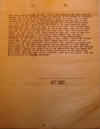 [p.
2] all
they could to help us
out. One of the bandits
ran down the hill passed
the G. N. carrying a
bomb consisting of 24
sticks of dynamite, he
was hit by the G. N.
causing him to drop the
bomb, but he kept
running in our
direction, Pvt. Morris
asked if he was one of
the G. N. one of the G.
N. immediately replied
no, so Pvt. Morris with
his rifle and Pvt. Macon
with the Lewis M. G.
both fired at him,
bringing him down about
14 yds. in front of
them. Pvt. Glaser and
Pvt. Russell did not
participate in the fight
more than two or three
minutes, as the latter
was hit the first shot
after the bomb gave the
alarm, he only fired
three shots after he was
hit, then he was hit
again putting him out of
the fight, Pvt. Glaser
was hit while passing
from barracks to office
also while enter the
office, therefore he did
not do any firing at
all. When I left the
office, there were only
Lt. Keimling, Pvt. Irwin
and Pvt. Foote left to
defend it but they
certainly did it well.
Lt. Keimling guarded the
front door at the same
time passed out
information to the
marines and Guardia as
to the locations of
different machine guns
and snipers also urging
them to be careful with
the ammunition and not
waste it. Pvt. Irwin and
Pvt. Foote were taking
good care of the rear
door, Pvt. Foote
shouting come on you
bandits, come out and
fight. All men did
excellent in obeying
commands. [p.
2] all
they could to help us
out. One of the bandits
ran down the hill passed
the G. N. carrying a
bomb consisting of 24
sticks of dynamite, he
was hit by the G. N.
causing him to drop the
bomb, but he kept
running in our
direction, Pvt. Morris
asked if he was one of
the G. N. one of the G.
N. immediately replied
no, so Pvt. Morris with
his rifle and Pvt. Macon
with the Lewis M. G.
both fired at him,
bringing him down about
14 yds. in front of
them. Pvt. Glaser and
Pvt. Russell did not
participate in the fight
more than two or three
minutes, as the latter
was hit the first shot
after the bomb gave the
alarm, he only fired
three shots after he was
hit, then he was hit
again putting him out of
the fight, Pvt. Glaser
was hit while passing
from barracks to office
also while enter the
office, therefore he did
not do any firing at
all. When I left the
office, there were only
Lt. Keimling, Pvt. Irwin
and Pvt. Foote left to
defend it but they
certainly did it well.
Lt. Keimling guarded the
front door at the same
time passed out
information to the
marines and Guardia as
to the locations of
different machine guns
and snipers also urging
them to be careful with
the ammunition and not
waste it. Pvt. Irwin and
Pvt. Foote were taking
good care of the rear
door, Pvt. Foote
shouting come on you
bandits, come out and
fight. All men did
excellent in obeying
commands.
ALVA EADENS,
SGT., USMC.
|
Document Inventory
||
INVENTARIO DE DOCUMENTOS
27.09.22.
DECLARACIONES DEL SARGENTO ALVA
EADENS
|
T R A N S C R I
P T I O N •
T R A N S C R I P C I Ó
N
Destacamento de la
Marina
Telpaneca, Nicaragua
22 septiembre de 1927.
DECLARACIÓN DEL SARGENTO ALVA
EADENS.
A las 1:00 A. M. del 19
de Septiembre 1927
mientras que el
Destacamento estaba
profundamente dormido y
la noche tan oscura que
no se veía más allá de
cinco a diez pies de las
puertas. Me despertó una
explosión muy fuerte a
sólo unos metros del
cuartel, salté de mi
litera y agarré mi rifle
y empezó desde la puerta
principal hasta los
cuarteles principales de
al lado, pero cuando
llegué a la puerta vi a
un hombre armado con un
rifle que miraba hacia
el almacén donde estaban
los cocineros y el
mensajero. Les grité a
ellos del peligro y en
ese momento el bandido
se volvió hacia mí y
llamó a un grupo de
bandidos en la parte
trasera a quienes podía
escuchar hablando en
español. Inmediatamente
disparé pero él no cayó
- sólo se tambaleó y se
agachó en la esquina
antes de que pudiera
volver a cargar y
disparar de nuevo. Eso
les impidió entrar por
la parte delantera. Ese
mismo hombre ya había
disparado un par de
tiros en el almacén,
matando al soldado raso
Russell. Mientras yo
estaba agachado
esperando a ver si
volvían otros, el
Capitán Keimling de la
G.N. quien estaba
durmiendo en la misma
oficina donde estaba yo,
salió corriendo por la
puerta a mi lado para
gritar algunas
instrucciones y palabras
de motivación a sus
hombres de la Guardia
Nacional también lo
mismo a los Marines en
los cuarteles
principales. Cuando
regresó a la oficina, el
fuego enemigo se estaba
poniendo bastante pesado
en la parte trasera de
los cuarteles (muchas
bombas explotando a
pocos metros de la
puerta). El tomó un par
de granadas de mano y se
paró en la puerta,
exponiéndose al fuego
muy intenso de los
rifles y a la explosión
de las bombas, y lanzó
las dos granadas en
diferentes direcciones
para evitar un ataque
con machete de los
bandidos; De vez en
cuando hacía esto. Creo
que se habrían
precipitado (los
bandidos) sobre nosotros
sino hubiese sido por
esto. El mantuvo a todos
los marines y hombres de
la G. N. animados
durante toda la noche
bromeando y animándolos
a lo largo de las horas
de la noche y
manteniéndolos
informados de las horas.
Estábamos completamente
rodeados de
francotiradores
equipados con rifles, y
en la colina a nuestro
oeste no más de
doscientos metros de
distancia, una
ametralladora disparaba,
también otra cerca de
unas 100 yardas de
distancia de nosotros,
pero todos nos cubrimos,
ya fuera dentro de los
edificios o bajo las
esquinas de los mismos.
En una casa, alrededor
de unos 20 a 30 yardas
de la puerta trasera del
Cuartel Principal,
parecía haber alrededor
de 15 a 20 hombres
concentrados con rifles
y machetes: Los hombres
con machetes estaban
afilando y golpeando los
machetes contra las
paredes dentro del
edificio y gritando en
español eso a los
marines. Y alrededor de
30 o 40 yardas, de una
de las galeras parecía
haber de entre 30 a 50
más de ellos – la
mayoría de las bombas
venían de ese lugar.
Todo esto no desmoralizó
a los Marines ni a la
Guardia, sólo les hizo
pelear más fuerte,
gritándoles a los
bandidos, diciéndoles
que vinieran, ellos
querían alcanzarlos con
un disparo libre.
Algunos de ellos estaban
lo suficientemente
nerviosos como para
intentarlo, se
arrastraron a menos de
quince o veinte pies de
nosotros antes de que
los descubriéramos, pero
tan pronto como fueron
descubiertos por
cualquier individuo,
todos éramos
inmediatamente
notificados de ello y
todas concentraríamos el
fuego en ese punto.
Todos juntos, como
hermanos. La G. N. luchó
como los Marines e
hicieron todo lo posible
para ayudarnos. Uno de
los bandidos corrió por
la colina pasó por la G.
N. llevando una bomba
que consistía en 24
cartuchos de dinamita,
fue atropellado por la
G.N. causando la caída
de la bomba, pero siguió
corriendo en nuestra
dirección, el Raso
Morris preguntó si era
uno de la G.N.
inmediatamente
respondieron no, por lo
que el Raso Morris con
su rifle y el Raso Macon
con la Lewis M. G.
dispararon contra él,
llevándolo a unos 14
metros en frente de
ellos. El Raso Glaser y
el Raso Russell no
participaron en la pelea
más de dos o tres
minutos, ya que este
último fue alcanzado por
el primer disparo
después de que la bomba
dio la alarma, sólo
disparó tres tiros
después de que fuera
impactado, luego fue
impactado de nuevo
poniéndolo fuera de
combate. El Raso Glaser
fue herido al pasar del
cuartel a la oficina
también al entrar en la
oficina, por lo tanto,
no hizo ningún disparo
en absoluto. Cuando salí
de la oficina, solo
quedaba el teniente
Keimling, Raso Irwin y
el Raso Foote para
defenderlo (el cuartel),
pero ciertamente lo
hicieron bien. El
teniente Keimling guardó
la puerta principal al
mismo tiempo pasó
información a los
marines y Guardia en
cuanto a las ubicaciones
de las ametralladoras y
los francotiradores,
también les instó a
tener cuidado con las
municiones y no
desperdiciarlas. El Raso
Irwin y Raso Foote
estaban cuidando bien la
puerta trasera, Raso
Foote daba gritos a los
bandidos, “vengan,
salgan y luchan”. Todos
los hombres hicieron un
excelente trabajo
obedeciendo las órdenes.
ALVA EADENS Eadens,
Sargento, USMC (Marina
de los Estados Unidos)
|
Document Inventory
||
INVENTARIO DE DOCUMENTOS
27.09.22. STATEMENT OF CPL. FREDERICK
CARLSON
(EN ESPAÑOL)
|
T R A N S C R I
P T I O N •
T R A N S C R I P C I Ó
N
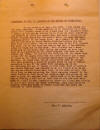 STATEMENT OF CPL. F.
CARLSON OF THE BATTLE OF
TELPANECA. STATEMENT OF CPL. F.
CARLSON OF THE BATTLE OF
TELPANECA.
On the morning of Sept.
19, 1927, I was asleep
in the main barracks. I
was awakened by an
explosion of a bomb
which I've learned later
to be a hand made one
(dynamite bomb). I
jumped up and put my
clothes on to cover my
white underwear, and
grabbed my rifle and
ammunition, and made a
break for my battle
station which was two
room's below the main
barracks, exposing
myself to the enemy
fire. As I jumped in the
room, and the men were
at their battle stations
keeping the men way with
their fire. One of the
men said to me, Pvt.
Russell was shot, but no
one knew how bad he was
hit, a few minutes later
we found out he was
dead. Pvt. Nichols and I
were stationed by the
front door facing the
plaza, we were kept busy
by pot shooting at the
enemy snipers, who were
in the church and trees.
At one off the building
off the north west
corner off the plaza
their was one Lewis
machine gun firing in
burst at the three
buildings which were
occupied by the marines.
At times when things
would quiet down we
thought they were
planning a machette
attack which we had to
expose ourselves to see
if the enemy were
sneaking up on us. Lt.
Keimling who was in
charge of this small
post of marines and
Guardia National has
cheered us up and fought
with us as any marine
officer would have done,
if not much better. All
night long we was
directing the fight
exposing himself to the
enemy trying to find
where the snipers were
and giving us the dope
to plug the snipers
fire. About 4:25 A. M.
we heard the bugler
blowing a call but at
that time we did not
know what kind of call
it was, immediately
after the firing was
letting up and 5 min.
after the enemy
retreated, this call
which we learned later
was blown to recall
their men and leave the
vicinity of their
battle.
CPL. F. CARLSON.
|
Document Inventory
||
INVENTARIO DE DOCUMENTOS
27.09.22. DECLARACIÓN DEL
CABO Frederick CARLSON
|
T R A N S C R I
P T I O N •
T R A N S C R I P C I Ó
N
DECLARACIÓN DEL CABO F.
CARLSON DE LA BATALLA DE
TELPANECA.
En la mañana del 19 de
septiembre de 1927,
estaba durmiendo en el
cuartel principal. Me
despertó una explosión
de una bomba la cual
luego descubrí que era
una bomba hecha a mano
(bomba de dinamita). Me
levanté y me puse la
ropa para cubrir mis
ropas interiores y
agarré mi rifle y mi
munición, e hice una
pausa por mi puesto de
mando, que estaba a dos
habitaciones debajo de
los cuarteles
principales,
exponiéndome al fuego
enemigo. Mientras me
zambullía en la
habitación, y los
hombres estaban en sus
puestos de batalla
manteniendo a los
enemigos fuera con sus
disparos; Uno de los
hombres me dijo: Al Raso
Russell le dispararon,
pero nadie supo lo mal
que fue herido, unos
minutos después nos
enteramos de que estaba
muerto. El soldado raso
Nichols y yo estábamos
estacionados por la
puerta de entrada frente
a la plaza, nos
mantuvimos ocupados
haciendo tiros a los
francotiradores
enemigos, que estaban en
la iglesia y los
árboles. En uno de los
edificios de la esquina
noroeste de la plaza
había una ametralladora
Lewis que disparaba en
ráfaga a los tres
edificios que estaban
ocupados por los
Marines. A veces, cuando
las cosas se
tranquilizaban,
pensábamos que estaban
planeando un ataque con
machete lo cual tuvimos
que exponernos para ver
si el enemigo nos estaba
siguiendo furtivamente.
El teniente Keimling que
estaba a cargo de este
pequeño puesto de
infantes de Marina y la
Guardia Nacional nos
estuvo animado y hubo
luchado con nosotros
como cualquier oficial
de Marina habría hecho,
si no mucho mejor. Toda
la noche estuvo
dirigiéndonos en la
batalla, exponiéndose al
enemigo tratando de
encontrar dónde estaban
los francotiradores y
dándonos información
para bloquear el fuego
de los francotiradores.
Alrededor de 4:25 A. M.
escuchamos el cornetín
enviando un llamado,
pero en ese momento no
sabíamos qué clase de
llamada era,
inmediatamente después
de que el fuego fuera
menguando y 5 min
después de que el
enemigo se retiró, este
llamado, el cual
descubrimos más tarde
era entonado para
retirar a sus hombres y
salir de las cercanías
de la batalla.
CABO F. CARLSON.
|
Document Inventory
||
INVENTARIO DE DOCUMENTOS
27.09.22. STATEMENT OF PVT. LAWRENCE C.
HANDZLIK
(EN ESPAÑOL)
|
T R A N S C R I
P T I O N •
T R A N S C R I P C I Ó
N
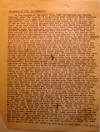 STATEMENT OF PVT. L. C.
HANDZLIK STATEMENT OF PVT. L. C.
HANDZLIK
On the morning of
September 19th, 1927 the
Marines and Guardia
Nacional under the
command of Lt. Keimling
when asleep in their
quarters were attacked
by a gang of bandits
which were under the
rebel leader, Gen.
Sandino. This attack
took place at one
o'clock in the morning
when it was so dark you
could not see very far
in front of yourself.
The first thing that
woke us up was a hand
made bomb which was
exploded in the rear of
our quarters. The first
rifle shot fired was
fired in the storeroom
where the cooks and
messmen were asleep. The
first shot had hit Pvt.
Russell who was sleeping
near the front door this
same shot went through
his bed and through mine
missing me by a few
inches. Pvt. Russell
after he was wounded
jumped up and grabbed
his rifle and fired
three shots and was shot
again near the heart. He
laid down his rifle and
went to his bed to lay
down and die, which he
done about 3 or 4 min,
after the fight started.
Lt. Keimling who was in
charge slept in the next
room and as soon as the
fight started he was on
the job just as any
Marine officer would do
if not better. He
cheered the Marines and
the Guardia Nacional as
much as any man could in
the position were were
in. All night long you
could hear Lt. Keimling
give out orders,
exposing himself to the
enemy finding out where
the snipers were and
giving orders where to
find them. The heaviest
firing was done on the
quarters of our Lt.
Keimling. This fight was
sure a hard one on us
men, but we sure stood
it though and sure have
loved to see them stay
for awhile it got light
so we could have showed
Sandino our
Marksmanship. The
heaviest attack of the
enemy was on the rear of
our quarters as they had
quite a few houses and
trees and shrubbery to
hide behind. You could
hear the machette men
congregated around the
buildings clattering
their machettes against
the building yelling
(Este por Marinos, Viva
la Sandino Muere Estadus
Unidos) they had one
machine gun firing at us
from the west of the
building and a
Sub-Thompson machine gun
with their rifle men
were firing from the
opposite end of the
building firing on us.
On the South west corner
of our quarters their is
two houses situated
their where their was a
gang estimated to be
from 40 to 50 men
hollering and cussing
the Marines. From these
two buildings they were
throwing their hand made
bombs and firing a
Thompson and a Lewis
machine gun, they had
thrown about 30 or 40
bombs from that
position, they had their
rifle men strung along a
line from the building
on the west to the
buildings on the
southwest. In the front
of the building I can
not say very much as my
post was toward the rear
of the building,
although I know they two
Lewis machine guns and
two or three
Sub-Thompson firing from
that point. Our battle
stations which were
strung out in three
rooms occupied by the
Marines were eleven men
in the main barracks,
five men in the office
and five men in the
store-room. When the
fight started every man
was at his post, some of
the men had to come down
from the main barracks
to their
battle-stations, which
was under heavy fire by
this time. Pvt. Glaser
who was also killed came
down from the main
barracks to the office
which was his post, was
shot as he was entering
the room. Immediately
Lt. Keimling and Sgt.
Eadens exposing
themselves to the enemy
grabbed Pvt. Glaser and
put him on the bunk so
he could rest easy and
during all the fighting
he was calling for water
which was given to him
by either Lt. Keimling
or Sgt. Eadens who were
taking chance of being
hit by the enemy. Sgt.
Eadens was in the office
had to go up to the main
barracks, he asked for
some one to guard the
door. Lt. Keimling said
give me your rifle, I'll
guard
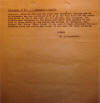 [ p. 2 ] the door,
which he did till the
fight was over. Pvt.
Ruddock who is an
automatic man was
stationed with me at the
rear door of the
store-room which we did
to the best of our
ability. Cpl. Carlsons,
Pvt. Nichols were
stationed at the front
door which they guarded
to the best of their
ability. The men in the
office, Lt. Keimling,
Sgt. Eadens, Pvt. Foote,
Irwin fought to the best
of their ability. The
main barracks which had
eleven men fought to the
best of their ability. [ p. 2 ] the door,
which he did till the
fight was over. Pvt.
Ruddock who is an
automatic man was
stationed with me at the
rear door of the
store-room which we did
to the best of our
ability. Cpl. Carlsons,
Pvt. Nichols were
stationed at the front
door which they guarded
to the best of their
ability. The men in the
office, Lt. Keimling,
Sgt. Eadens, Pvt. Foote,
Irwin fought to the best
of their ability. The
main barracks which had
eleven men fought to the
best of their ability.
SIGNED
PVT. L. C. HANDZLIK.
|
Document Inventory
||
INVENTARIO DE DOCUMENTOS
27.09.22. DECLARACIÓN DEL
SOLDADO RASO L. C. HANDZLIK
|
T R A N S C R I
P T I O N •
T R A N S C R I P C I Ó
N
DECLARACIÓN DEL RASO L.
C. HANDZLIK
En la mañana del 19 de
septiembre de 1927, los
marines y la Guardia
Nacional bajo el mando
del teniente Keimling,
cuando dormían en sus
Cuarteles, fueron
atacados por una banda
de bandidos que estaban
bajo mando del líder
rebelde, el General
Sandino. Este ataque
tuvo lugar a las una de
la madrugada cuando
estaba tan oscuro que no
era posible ver más
lejos de delante de uno
mismo. Lo primero que
nos despertó fue una
bomba hechiza que
estalló en la parte
trasera de nuestros
cuartos. El primer tiro
que se disparó fue
dirigido en el almacén
donde los cocineros y
mensajeros estaban
dormidos. El primer
disparo había impactado
al soldado raso Russell,
que estaba durmiendo
cerca de la puerta de
entrada, pasó por su
cama y por la mía
faltando unos cuantas
pulgadas para
alcanzarme. El soldado
raso Russell después de
que fue herido saltó y
agarró su rifle y
disparó tres disparos y
fue impactado nuevamente
cerca del corazón. Dejó
su rifle y se fue a su
cama para echarse y
morir, lo que hizo unos
3 o 4 minutos después de
la lucha comenzó. El
teniente Keimling quien
estaba a cargo dormía en
la habitación de al lado
y tan pronto como
comenzó la batalla, él
se dispuso al trabajo
como cualquier oficial
de la Marina haría sino
mejor. Él animo a los
marines y a la Guardia
Nacional tanto como
cualquier hombre podía
en la posición en la que
se encontraban. Durante
toda la noche se podía
oír al teniente Keimling
dar órdenes,
exponiéndose al enemigo
averiguando dónde
estaban los
francotiradores y dando
órdenes a dónde
encontrarlos. El tiroteo
más pesado fue hecho en
los cuarteles de nuestro
teniente Keimling. Esta
pelea fue con seguridad
una de las más duras
sobre nuestros hombres,
pero con seguridad
nosotros nos opusimos a
esta y ciertamente
hubiésemos amado el ver
a nuestros hombres
quedarse, tener luz por
un momento y así poder
mostrarle a Sandino
nuestra puntería. El
mayor ataque del enemigo
se concentró en la parte
trasera de nuestros
cuarteles, ya que tenían
algunas pocas casas y
árboles y arbustos para
esconderse detrás. Se
podía oír a los hombres
con machetes que estaban
congregados alrededor de
los edificios, afilando
y golpeando sus machetes
contra el edificio y
gritaban: (Este por
marinos, Viva la
Sandino, muere Estados
Unidos) Ellos tenían una
ametralladora
disparándonos desde el
oeste del edificio y una
ametralladora
Sub-Thompson con sus
hombres con rifles que
disparaban desde el
extremo opuesto del
edificio, disparando
contra nosotros. En la
esquina suroeste de
nuestros cuarteles se
encuentran dos casas
situadas donde se
encontraba una pandilla
estimada entre 40 y 50
hombres gritando y
maldeciendo a los
marines. De estos dos
edificios, ellos
arrojaban sus bombas
hechas a mano y
disparaban una Thompson
y una ametralladora
Lewis, ellos habían
arrojado unas 30 o 40
bombas de esa posición,
tenían sus rifles
puestos a lo largo de
una de las líneas desde
el edificio hacia el
oeste hasta los
edificios en el
suroeste. En la parte
delantera del edificio,
no puedo decir mucho, ya
que mi puesto estaba en
la parte trasera del
edificio, aunque sé que
dos ametralladoras Lewis
y dos o tres
sub-Thompson disparaban
desde ese punto.
Nuestras estaciones de
combate, que se
encontraban en tres
habitaciones ocupadas
por los marines, eran
once hombres en el
cuartel principal, cinco
hombres en la oficina y
cinco hombres en el
almacén. Cuando la
batalla empezó, todos
los hombres estaban en
sus puestos, algunos de
los hombres tenían que
bajar de los cuarteles
principales a sus
puestos de batalla, los
cuales estaban bajo
fuego pesado en ese
momento. El soldado raso
Glaser, que también fue
asesinado, bajó desde el
cuartel principal hasta
la oficina que era su
puesto, fue fusilado
mientras entraba en la
habitación.
Inmediatamente el
teniente Keimling y el
Sargento Eadens
exponiéndose al enemigo
agarraron al soldado
Glaser y lo pusieron en
la litera para que
pudiera descansar
tranquilo y durante
todas la lucha él estuvo
pidiendo agua que le fue
dada por el teniente
Keimling o el sargento
Eadens quienes estaban
expuestos a ser
impactados por el
enemigo. El Sargento
Eadens que estaba en la
oficina tuvo que subir a
los cuarteles
principales, pidió que
alguien vigilara la
puerta. El teniente
Keimling me dijo “dame
tu rifle, yo vigilaré…
[p. 2] la puerta”, lo
que hizo hasta que
terminó la batalla. El
Soldado raso Ruddock,
que es un hombre
automático, estaba
parado conmigo en la
puerta trasera del
almacén, lo cual hicimos
a la mejor de nuestras
posibilidades. El Cabo
Carlsons, Raso Nichols
estaban estacionados en
la puerta principal, la
que defendieron lo mejor
posible. Los hombres de
la oficina, teniente
Keimling, sargento
Eadens, Raso Foote,
Irwin lucharon de lo
mejor posible. Los
cuarteles principales
que tenían once hombres
lucharon al máximo de
sus capacidades.
FIRMADO
Soldado L. C. HANDZLIK.
|
Document Inventory
||
INVENTARIO DE DOCUMENTOS
27.09.21. STATEMENT OF
PVT. VESPER L. NICHOLS
(EN ESPAÑOL)
|
T R A N S C R I
P T I O N •
T R A N S C R I P C I Ó
N
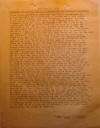 September
21 1927. September
21 1927.
STATEMENT OF PRIVATE
VESPER L. NICHOLS OF THE
BATTLE OF TELPANECA
On or about one O'clock
September the 19th I was
aroused by a loud
explosion which
afterwards I learned was
a bomb thrown by the
native rebels under the
leadership of General
Sandino. I got out
of a native bed which I
was sleeping on in the
storerrom where the
cooks and messmen sleep
and I put on my clothes
and shirt as Lieut.
Kiemling had told us to
do in any case such as
the one that took place.
I picked up my belt and
two bandoleers and went
to the front door which
faces the Plaza.
The first thing I saw
was a native rifleman
running around the
corner and I afterwards
learned that this native
was the one who shot and
killed Pvt Russell who
slept in a bed in the
same room. I was
on my way to the door
when I heard Pvt.
Russell exclaim "Oh,
slick they got me."
Pvt Russell told me that
he was hit in the side
he fired three shots in
the general diretion of
the Plaza and returned
to his bed where he died
shortly afterwards.
My post was at the front
of the storeroom,
Corporal Carlson and
myself occupying the
door facing the Plaza.
The front of the
building was fired upon
by a Machine (Thompson
Sub-Machine Gun) gun and
I afterwards learned
that it was this gun
that hit and mortally
wounded Pvt. Glazier.
It was quiet in the
front except for an
occasional burst from
the Machine gunner and a
sniper who fired about
five shots from the
church tower.
Corporal Carlson and I
fired several shots
toward the church tower
and he stopped fireing
[firing] it seemed as
though we hit the sniper
as he stopped firing so
suddenly. It was
quiet in the front of
the building for the
rest of the battle save
for an occasional burst
of machine gun fire and
an enemy sniper on the
hill. Privates
Handzlik and Ruddock
were staioned at the
rear door of the
storeroom. Pvt.
Ruddock had an automatic
rifle which was in
operation all during the
battle. They
fought well, firing only
when they saw something
to fire at saving their
ammunition as well as
possible. During
the battle many bombs
exploded in the rear of
the building the enemy
were firing steadily all
the time. I could
distinguish three or
four machine guns in the
rear by their rate of
fire. During the
battle Lieut. Keimling
stood out as a prominent
figure as it was he who
would urge the Marines
and Guardia on to the
fight I could hear his
voice and it was a great
thing to hear him and
see him directing the
fire and exposing
himself, it was he that
kept up the Morale of
the Marines and Guardia.
The most demoralizing
thing was the native
machete men wheting
[whetting] their
machetes against the
building and yelling
"Esta por Marines."
The Marines all during
the fight were talking
back and forth and
firing in the direction
from where the noises
came. These were
the outstanding things
of the battle. I
put down here what
happened to the best of
my ability and if
anything I did not give
Lieut. Keimling all the
credit he deserves.
PVT. VESPER B. NICHOLS
|
Document Inventory
||
INVENTARIO DE DOCUMENTOS
27.09.21. DECLARACIÓN DE
PVT. VESPER L. NICHOLS
|
T R A N S C R I
P T I O N •
T R A N S C R I P C I Ó
N
21 de septiembre de
1927.
DECLARACIÓN DEL SOLDADO
RASO VESPER L. NICHOLS
SOBRE LA BATALLA DE
TELPANECA
Alrededor o a las una de
la mañana del día 19 de
septiembre, me despertó
una fuerte explosión, la
que después me enteré de
que era una bomba
lanzada por los rebeldes
nativos bajo la
dirección del General
Sandino. Salí de una
cama nativa en la que
dormía en el cuarto del
almacén donde los
cocineros y los
mensajeros duermen y me
puse mis ropas y camisa
a como nos instruyó el
Teniente Kiemling en
cualquier circunstancia
como la que tuvo lugar.
Tome mí cinturón y dos
bandoleras, y fui hacia
la puerta principal que
da a la Plaza. Lo
primero que vi fue un
fusilero nativo
corriendo por la esquina
y luego me enteré de que
este nativo fue el que
disparó y mató al
soldado Russell que
dormía en una cama en la
misma habitación. Yo
estaba en mi camino
hacia la puerta cuando
escuché al soldado raso
Russell exclamar: "Oh,
demonios me dieron" El
soldado Russell me dijo
que fue impactado en el
lado que detonó tres
disparos en la dirección
general de la Plaza y
regresó a su cama donde
murió poco después. Mi
puesto estaba en la
parte delantera del
almacén, el cabo Carlson
y yo ocupando la puerta
que daba a la Plaza. La
parte delantera del
edificio fue atacado con
una ametralladora
(ametralladora
Sub-Thompson) y después
me enteré de que era
esta arma la que impactó
e hirió mortalmente al
soldado raso Glazier.
Estaba tranquilo en el
frente, excepto por una
ráfaga ocasional del
artillero y el
francotirador quien
detonó unos cinco
disparos desde la torre
de la iglesia. El cabo
Carlson y yo disparamos
varios tiros hacia la
torre de la iglesia y
dejó de disparar, al
parecer nosotros
alcanzamos impactar al
francotirador dado a que
dejó de disparar tan de
repente. Estaba muy
tranquilo en la parte
delantera del edificio
para el resto de la
batalla, salvo por el
estallido ocasional de
las ráfagas de la
ametralladora y un
francotirador enemigo en
la colina. Los soldados
rasos Handzlik y Ruddock
estaban colocados en la
puerta trasera del
almacén. El Soldado raso
Ruddock tenía un rifle
automático que estabo en
funcionamiento durante
toda la batalla. Ellos
lucharon bien,
disparando sólo cuando
veían algo a que
disparar y racionando
sus municiones lo mejor
posible. Durante la
batalla muchas bombas
estallaron en la parte
trasera del edificio, el
enemigo estaba
disparando asiduamente
todo el tiempo. Yo podía
distinguir tres o cuatro
ametralladoras en la
parte trasera por su
velocidad de tiro.
Durante la batalla el
Teniente Keimling se
destacó como una figura
prominente, ya que fue
él quien instó a los
marines y Guardia a la
pelea, yo podía oír su
voz y fue una gran cosa
oírlo y verlo dirigiendo
el fuego y exponiéndose,
fue él quien mantuvo la
moral de los Marines y
Guardias. La cosa más
desmoralizadora fue los
hombres nativos con sus
machetes afilando sus
machetes contra el
edificio y gritando
"Esta por Marines". Los
marines durante toda la
pelea estaban hablando
de un lado a otro y
disparando en la
dirección de donde
provenían los ruidos.
Estas fueron las cosas
sobresalientes de la
batalla. Puse aquí lo
que pasó a lo mejor de
mi capacidad y sí algo
obvie, no le di al
Teniente Keimling todo
el crédito que se
merece.
SOLDADO RASO VESPER B.
NICHOLS
|
Document Inventory
||
INVENTARIO DE DOCUMENTOS
27.09.23. STATEMENT OF
PVT. RODGERS H. IRWIN
(EN ESPAÑOL)
|
T R A N S C R I
P T I O N •
T R A N S C R I P C I Ó
N
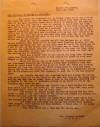 Marine
Detachment, Marine
Detachment,
Sept. 23, 1927
THE STATEMAN [STATEMENT]
OF BATTLE AT TELPANECA
The battle of Telpaneca
was on Sunday night
about one o'clock the
alarm was given when the
enemy threw a large bomb
just on the outside of
the main barracks their
[there] was a sentry on
guarde [guard] in the
rear of [sic]
he saw the man jump
behind a tree he started
to shoot when the bomb
went off as soon as the
bomb exploded I rused
[rushed] in the main
barracks and told them
to brack [break] out as
soon as i hollowed [I
hollered] I got my arms
which was a tompson
[Thompson] submachine
gun I rushed to my
battle station which was
in the office one of the
men that was stationed
with me was just behind
me we started in the
door way [doorway] about
the same time when some
one of the enemy with a
tompson [Thompson]
machine gun shot in the
door way he was the one
that killed one of the
marines.
After the battle started
and all the Marines was
at their battle stations
they sure had to do some
hard fighting because
all the enemysmen
[enemy's men] was drunk
and that is why they
were so brave the enemy
was in [within] 5 and 10
feet of the office their
main reason was to wreck
the office and kill the
Lieutenant that was in
command of the post for
they think when the
commander is dead that
we will give in to them
but that isn't the
Marines way of fighting.
Their [There] was a
heavy fire on the office
for they were throwing
bombs they threw about
20 bombs at the office
but didnt [didn't] do
very much damage to the
building.
While the battle was at
its worst the Lieutenant
which name was
Lieutenant Kiemling
[Keimling] was fireing
[firing] a forty five
automatic from the doors
he would stand between
the doors in which the
enemy was fireing
[firing] through and
fire his pistol and
throw handgernads [hand
grenades] he sure was
brave during the battle
and fought hard he would
keep us in ammunition
during the battle
crawling a cross
[across] the doorways to
each one of the men
helping them.
The
Guardia Nacional was
fighting hard all during
the battle they would
rush out on the porch in
the open and fire at the
enemy their [there] was
one man that was an
enemy threw a bomb in
the Guardia quarters and
a Guardia by the name of
Galanamca [Raso Justo
Salamanca] picked it up
threw it out of the
building away from the
men.
The
men both Marines and
Guardia had a hard
battle but they done
their part well and
saved all the ammunition
they [the] best they
could for they didn't
know how long it would
last.
The
Sargint [Sargent] in
charge fought bravely he
killed the man that
tried to rush in the
front door of the ofice
and fought all during
the battle hard his name
was Sargent Eadens.
All
during the battle the
enemy would blow bugle
calls for the charges
and when the battle was
over they blew asemble
[assemble] and retreat.
The
enemy was hollowing
[hollering] all during
the battle Vava [Viva]
Sandino, Vava [Viva]
Salgado, Vava [Viva]
Sanchez and Vava [Viva]
Estrada. I think
some of the enemy was of
all four generals.
I
hope this gives you a
[an] idea how the battle
was.
Pvt. Rodgers H. Irwin
U.S.M.C.
|
Document Inventory
||
INVENTARIO DE DOCUMENTOS
27.09.23. DECLARACIÓN DE
PVT. RODGERS H. IRWIN
|
T R A N S C R I
P T I O N •
T R A N S C R I P C I Ó
N
DECLARACIÓN SOBRE LA
BATALLA EN TELPANECA
La batalla
de Telpaneca fue el
domingo por la noche a
eso de la una en punto
la alarma fue dada
cuando el enemigo arrojó
una gran bomba justo en
el exterior de los
cuarteles principales.
Había un centinela en la
guardia en la parte
trasera del cuartel. El
vio al hombre saltar
detrás de un árbol, el
empezó a disparar cuando
la bomba explotó, tan
pronto como explotó la
bomba yo me apresuré en
dirección al cuartel
principal y les dijo a
salieran. Tan pronto
como les grite dando la
alarma, tomé en mis
brazos una ametralladora
Thompson, me apresure
hacia mi estación de
batalla que estaba en la
oficina. Uno de los
hombres que estaban
estacionados conmigo
estaba justo detrás de
mí, comenzamos en el
corredor cuando al mismo
tiempo alguien de los
enemigo con una
ametralladora Thompson
disparó hacia el
corredor, este fue el
que mató a uno de los
marines.
Después de que la
batalla comenzó y todos
los infantes de marina
estaban en sus
estaciones de la
batalla, ellos seguro
tuvieron que haber dado
una dura batalla porque
todos los hombres del
enemigo eran borrachos y
esa era la razón del
porqué eran tan
aguerridos. El enemigo
estaba dentro de unos 5
y 10 pies de la oficina,
su razón principal era
irrumpir en la oficina y
matar al teniente que
estaba al mando del
puesto, porque piensan
que cuando el comandante
muere nos cederemos a
ellos, pero esa no es la
manera de pelear de los
Marines.
Había un tiroteo pesado
en la oficina porque
lanzaban bombas. Ellos
lanzaron alrededor de 20
bombas en la oficina
pero estas no hicieron
mucho daño al edificio.
Mientras que la batalla
estaba en su peor
momento, el teniente
cuyo nombre era el
teniente Keimling,
estaba disparando un
arma automática calibre
cuarenta y cinco desde
la puerta en la que
estaba instalado entre
la puerta en la que el
enemigo estaba
disparando, y disparando
su pistola y lanzó
granadas de mano. El
ciertamente fue valiente
durante la batalla y
luchó fuertemente para
mantenernos con
suficientes municiones
durante la batalla,
gateando a través de los
pasillos hacia cada uno
de los hombres,
ayudándoles.
La Guardia
Nacional luchaba
duramente durante toda
la batalla, ellos salían
corriendo por el pórtico
al aire libre y
disparaban contra el
enemigo. Hubo un hombre
que era un enemigo,
lanzó una bomba en los
cuarteles de la Guardia
y una Guardia con el
nombre de Galanamca
[Raso Justo Salamanca]
la cogió y la arrojó del
edificio lejos de los
hombres.
Los hombres
tanto Marines como
Guardia tuvieron una
dura batalla pero
hicieron bien su parte y
guardaron toda la
munición a la mejor de
sus posibilidades porque
no sabían cuánto tiempo
duraría la batalla.
El Sargento
al mando luchó
valientemente, mató al
hombre que intentó
ingresar rápidamente en
la puerta delantera de
la oficina, y luchó
duramente durante la
batalla, su nombre era
Sargento Eadens.
Durante
toda la batalla, el
enemigo lanzo las
llamadas de corneta para
la carga y cuando la
batalla terminó ellos
entonaron la llamada
para la retirada.
El enemigo estaba
gritando fuertemente
durante toda la batalla:
“Viva Sandino, Viva
Salgado, Viva Sánchez y
Viva Estrada”. Creo que
algunos de los enemigos
eran los cuatro
generales.
Espero que
esto te dé una idea de
cómo fue la batalla.
Soldado Raso Rodgers H. Irwin
U.S.M.C.
|
Document Inventory
||
INVENTARIO DE DOCUMENTOS
27.09.23. STATEMENT OF
PVT. DANIEL E. MACON
(EN ESPAÑOL)
|
T R A N S C R I
P T I O N •
T R A N S C R I P C I Ó
N
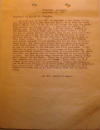 TELPANECA,
Nicaragua TELPANECA,
Nicaragua
September 23, 1927.
STATEMENT OF BATTLE OF
TELPANECA.
At 1:00 a.m. on the 20th of September I was asleep in
the Main Barracks when a
bomb went off waking me
up then the sentry
yelled "Break out," I
got up and all around
the hill the gooks were
yelling and firing
rifles. I then
took my post at the
machine gun. There
were men all over the
square, closing up the
barracks throwing bombs
and firing their rifles.
I got the gun in action
driving the gooks back
at the same time I was
using the machine gun
the rest of the Marines
were at their post and
firing. The
Guardia Nationale was
firing as fast as they
could reload.
Capt. H. S. Kiemling was
in his command post
giving commands to the
Guardia and the marines,
directing their fire.
The Gooks were driven
back to where the
rifleman could hold the
front. Captain
Kiemling directed me to
take my gun to the rear
of the barracks and
drive them back. I
did and took my post in
a doorway in the rear of
the barracks. The
enemy were close
throwing bombs close to
the barracks. We
opened fire with the
machine gun and drove
them back to the
buildings in rear.
The Gook buglers were
scattered around blowing
charge after charge for
the enemy. There
was a continuous string
of fire between the
Marines and the Enemy.
Every time the fire
slowed up we could hear
the Lieutenant's command
and asking us how we
were and telling us to
shoot slower and save
our ammunition.
From then on till 4:30
in the morning it was
continuous fire between
the enemy and us at 4:30
retreat blew and the
battle ended.
/s/ Pvt. Daniel E.
Macon
|
Document Inventory
||
INVENTARIO DE DOCUMENTOS
27.09.23. DECLARACIÓN DE
PVT. DANIEL E. MACON
|
T R A N S C R I
P T I O N •
T R A N S C R I P C I Ó
N
TELPANECA, Nicaragua
23 de septiembre de
1927.
DECLARACIÓN DE LA
BATALLA DE TELPANECA.
A las 1:00 de la mañana
del 20 de septiembre
estaba durmiendo en el
Cuartel Principal cuando
una bomba se disparó
despertándome, entonces
el centinela gritó
"Explosión", me levanté
y alrededor de la colina
los “gooks” (jerga de
militares de EU
peyorativa y ofensiva
para referirse a los
enemigos) gritaban y
disparaban rifles.
Entonces tomé mi puesto
en la ametralladora.
Había hombres por todo
el cuadro, cerrando el
cuartel lanzando bombas
y disparando sus rifles.
Tomé el arma en acción,
conduciendo a los
“gooks” de retroceso, al
mismo tiempo que
utilizaba la
ametralladora el resto
de los infantes de
marina estaban en sus
puestos y disparando. La
Guardia Nacional estaba
disparando tan rápido
como podía recargar. El
capitán H. S. Kiemling
estaba en su puesto de
mando dando órdenes a la
Guardia y los marines,
dirigiendo el fuego. Los
“Gooks” fueron dirigidos
de retroceso hasta donde
el fusilero podía
mantener el frente. El
capitán Kiemling me
ordenó que llevara mi
pistola a la parte
trasera del cuartel y
los llevara de regreso.
Lo hice y tomé mi puesto
en una puerta en la
parte trasera del
cuartel. El enemigo
estaba cerca lanzando
bombas cerca del
cuartel. Abrimos fuego
con la ametralladora y
los llevamos de regreso
a los edificios en la
parte trasera. Los
buglers Gook estaban
dispersos alrededor de
la carga de soplar
después de la carga para
el enemigo. Había una
hilera continua de fuego
entre los marines y el
enemigo. Cada vez que el
fuego se ralentizaba,
podíamos oír el comando
del teniente y
preguntarnos cómo
estábamos y diciéndonos
que disparáramos más
despacio y guardáramos
nuestra munición. A
partir de entonces hasta
las 4:30 de la mañana
fue un fuego continuo
entre el enemigo y
nosotros a las 4:30 de
retiro sopló y la
batalla terminó.
/ S / Soldado Daniel E.
Macon
|
Document Inventory
||
INVENTARIO DE DOCUMENTOS
27.09.22. STATEMENT OF
PVT. HERBERT E. MARSH
(EN ESPAÑOL)
|
T R A N S C R I
P T I O N •
T R A N S C R I P C I Ó
N
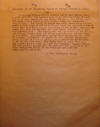 STATEMENT OF
THE TELPANECA BATTLE BY
PRIVATE HERBERT E. MARSH STATEMENT OF
THE TELPANECA BATTLE BY
PRIVATE HERBERT E. MARSH
It was one o'clock
Monday morning [19th]
and we were awoken when
a bomb went off.
The sentrys [sentries]
came in an [and]
hollered break out and
all of us were headed
for our battle stations.
The Battle start[ed],
the bandits were
fighting with rifles,
bomb[s], and mecheatres
[machetes], machine
guns. The Lieut.
in charge was doing
every thing in his power
to incourage [encourage]
us and told us just
where the men were
situated. There
were five mules killed
there [they] were at out
picket line and the
enemy must have cut the
wire [to] let them
stroll around and in
that way they were shot.
The Guardia did very
fine work at the Battle.
One Guardia threw a bomb
out of his quarters that
had ben [been] threw
[thrown] by the enemy.
The enemy were making
thre [their] charges by
the sound of a bugle.
The Lieut. in charge all
the time the Battle was
going on told us to be
as sparring [sparing]
with ammunition as we
could as we did not have
much. The Battle
went on until 4:30 a.m.
and retreat went at 4:30
a.m. and they vacated.
Sargent Eadens did very
good in the Battle.
He came from one of the
building[s] to the other
during the battle to fix
the stoppages and
refilled Lewis machine
gun drums.
/s/ Pvt. Herbert
E. Marsh
|
Document Inventory
||
INVENTARIO DE DOCUMENTOS
27.09.22. DECLARACIÓN DE
PVT. HERBERT E. MARSH
|
T R A N S C R I
P T I O N •
T R A N S C R I P C I Ó
N
DECLARACIÓN DE LA
BATALLA DE TELPANECA POR
EL SOLDADO RASO HERBERT
E. MARSH
Era la una de la mañana
del lunes (19) y fuimos
despertados cuando una
bomba explotó. Los
centinelas vinieron y
gritaron Explosión y
todos nosotros nos
fuimos dirigidos a
nuestras estaciones de
batalla. La batalla
comenzó, los bandidos
luchaban con rifles,
bombas, y machetes,
ametralladoras. El
teniente a cargo hacía
todo lo posible para
motivarnos y nos decía
dónde estaban los
hombres situados. Hubo
cinco mulas asesinadas
allí, ellas estaban en
cerca y el enemigo debió
haber cortado el alambre
para permitirles
deambular y de esa
manera les dispararon.
La Guardia hizo un
trabajo muy bueno en la
batalla. Un Guardia
arrojó una bomba de sus
aposentos que había sido
lanzada por el enemigo.
El enemigo hacían sus
ataques al sonido de un
clarín. El teniente a
cargo, durante todo el
tiempo de la Batalla,
estuvo diciéndonos que
fuéramos como racionales
con las municiones a
como pudimos ya que no
teníamos mucho. La
batalla continuó hasta
las 4:30 de la mañana y
el retiro fue a las 4:30
de la mañana y ellos se
fueron. Sargent Eadens
hizo un buen desempeño
en la batalla. Vino de
uno de los edificios al
otro durante la batalla
para arreglar los
atascos y rellenar los
tambores de metralleta
Lewis.
Soldado raso Herbert E.
Marsh
|
Document Inventory
||
INVENTARIO DE DOCUMENTOS
|
T R A N S C R I
P T I O N •
T R A N S C R I P C I Ó
N
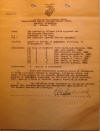 UNITED STATES
MARINE CORPS UNITED STATES
MARINE CORPS
HEADQUARTERS SECOND BRIGADE MARINE
CORPS.
MANAGUA, NICARAGUA
21 October 1927.
|
From:
|
The Commanding
Officer Fifth
Regiment and The Brigade Commander
|
|
To:
|
Secretary of the Navy
|
|
Via:
|
The Commander Special Services
Squadron.
|
|
|
|
|
Subject:
|
Report on
defense of
TELPANECA,
Nicaragua, on 19
September 1927.
|
|
|
|
|
References:
|
(a) Copy
of statement of
First Lieut. H.
S. Keimling,
USMC
|
|
|
(b) "
"
Sgt Alva Eadens,
USMC
|
|
|
(c) "
"
Cpl. Frederick
Carlson, USMC
|
|
|
(d) " " Pvt. Lawrence Handzlik, USMC
|
|
|
(e) " " Pvt. Vesper L. Nichols, USMC
|
|
|
(f) "
"
Pvt. Rodgers H.
Irwin, USMC
|
|
|
(g) "
"
Pvt. Daniel E.
Macon, USMC
|
|
|
(h) "
"
Pvt. Herbert E.
Marsh, USMC
|
|
|
|
|
Inclosures:
|
8 (copies of
references)
|
1.
There are transmitted herewith
copies of statements of First
Lieutenant Herbert S. Keimling, U.S.
Marine Corps, and seven of the
members of his command, describing
the successful defense of TELPANECA,
Nicaragua, on the night of 18-19
September, 1927, against a force of
bandits, greatly superior in
numbers.
2.
The defending force consisted of one
Marine Officer Twenty (20) enlisted
Marines and Twenty-five (25)
enlisted of the Guardia Nacional de
Nicaragua.
/s/ L. M. GULICK
-------------------------------------------------------
All in
RG127/113C/12
|
Document Inventory
||
INVENTARIO DE DOCUMENTOS
27.10.21. COMANDANTE DE LA
BRIGADA GULICK AL SECRETARIO DE
LA ARMADA
|
T R A N S C R I
P T I O N •
T R A N S C R I P C I Ó
N
CUERPO DE MARINES DE LOS ESTADOS
UNIDOS
SEDE DE LA SEGUNDA BRIGADA DEL
CUERPO DE LA MARINA.
MANAGUA, NICARAGUA
21 de octubre de 1927.
|
De:
|
El Comandante
del Quinto
Regimiento y el
Comandante de la
Brigada
|
|
A:
|
Secretario de la
Armada
|
|
Vía:
|
El Comandante
del Escuadrón de
Servicios
Especiales.
|
|
|
|
|
Sujeto:
|
Informe de la
defensa de
TELPANECA,
Nicaragua, el 19
de septiembre de 1927.
|
|
|
|
|
Referencias:
|
(A) Copia de la
declaración del
Primer Teniente
H. S. Keimling,
USMC
|
|
|
(B) " " Sargento
Alva Eadens,
Cuerpo de la
Marina de los
Estados Unidos
(por sus siglas
“USMC”)
|
|
|
(C) " " Cabo
Frederick
Carlson, USMC
|
|
|
(D) " " Soldado
Raso Lawrence
Handzlik, USMC
|
|
|
(E) " " Soldado
Raso Vesper L.
Nichols, USMC
|
|
|
(F) " " Soldado
Raso Rodgers H.
Irwin, USMC
|
|
|
(G) " " Soldado
Raso Daniel E.
Macon, USMC
|
|
|
(H) " " Soldado
Raso Herbert E.
Marsh, USMCC
|
|
|
|
|
Adjuntos
|
8 (copias de
referencias)
|
1. Se
transmiten copias de las
declaraciones del Primer
Teniente Herbert S.
Keimling del Cuerpo de
Marines de los Estados
Unidos y de siete
miembros de su mando,
describiendo la exitosa
defensa de TELPANECA,
Nicaragua, en la noche
del 18 al 19 de
septiembre de 1927,
contra una fuerza de
bandidos, muy superior
en número.
2. La fuerza defensora consistía en
un oficial de Marina de
veinte (20) Marines
enlistados y veinticinco
(25) enlistados de la
Guardia Nacional de
Nicaragua.
/f/ L. M. GULICK
-------------------------------------------------------
Todo en
RG127/113C/12
|
Document Inventory
||
INVENTARIO DE DOCUMENTOS
27.09.20. AUXILIARY DOC 1: SANDINO'S ACCOUNT OF
THE BATTLE OF TELPANECA
(EN ESPAÑOL)
T R A N S C R I
P T I O N •
T R A N S C R I P C I Ó
N
Ancillary Document:
Sandino's Account
of the Battle of Telpaneca of 19 September 1927
El Chipote
September 20, 1927
The obstinacy of the President of the United States, Mr.
Calvin Coolidge, continues to be the cause of the
shedding of blood in Nicaragua. On the 19th of the
present month there was a bloody battle in the village
of Telpaneca, which came about in the following manner.
I ordered a cavalry unit to the edge of that town under
the command of Colonel Carlos Estrada, in order to
provide protection to our authorities, because we knew
the Yankees were pursuing them pitilessly, and that the
constabularies [Guardia Nacional] were under orders to
murder those same authorities. Our cavalry arrived on
the outskirts of the town at twelve o'clock at night
and, in accordance with their order and the plan they
had been given, they began to encircle the enemy.
At 12:45 the first shot rang out against the enemy
barracks, and simultaneously firing began against the
other enemy units. An hour later my men had managed to
dislodge the enemy from their outer positions, and
little by little they were gaining control of the
village. But when they had gotten into the town the
enemy exploded some mines, though without doing any
damage. The struggle became even more hard-fought,
because the enemy had their line of fire in the form of
a square in all the village houses with their high
windows, and in each house there were four machine guns.
The thrust of my people into the village was heroic, and
they managed to reduce the invaders to a few houses and
to capture three machine guns, forty-two rifles, and
about fifty thousand rounds of ammunition for rifles and
machine guns, and the number of dead among the machos
[Marines] and the constabularies was reckoned at eighty.
Concerning my men, they amused themselves by collecting
supplies from the forward barracks. Dawn came, and they
had to retire to the sound of the trumpet, or rather
before the famous ball that is the sun. The eighty
deaths of which I speak were those of the enemy alone.
/s/ A. C. SANDINO
Source: Robert E. Conrad,
Sandino, Testimony
of a Nicaraguan Patriot (Princeton, 1990), p. 102
|
Document Inventory
||
INVENTARIO DE DOCUMENTOS
27.09.20.
DOC AUXILIAR NÚM. 1:
RECUENTO DE SANDINO DE LA
COMBATE DE TELPANECA DEL 19 DE
SEPTIEMBRE DE 1927
SANDINO, EL CHIPOTE, "EL COMBATE DE TELPANECA"
(20 DE SEPTIEMBRE DE 1927)
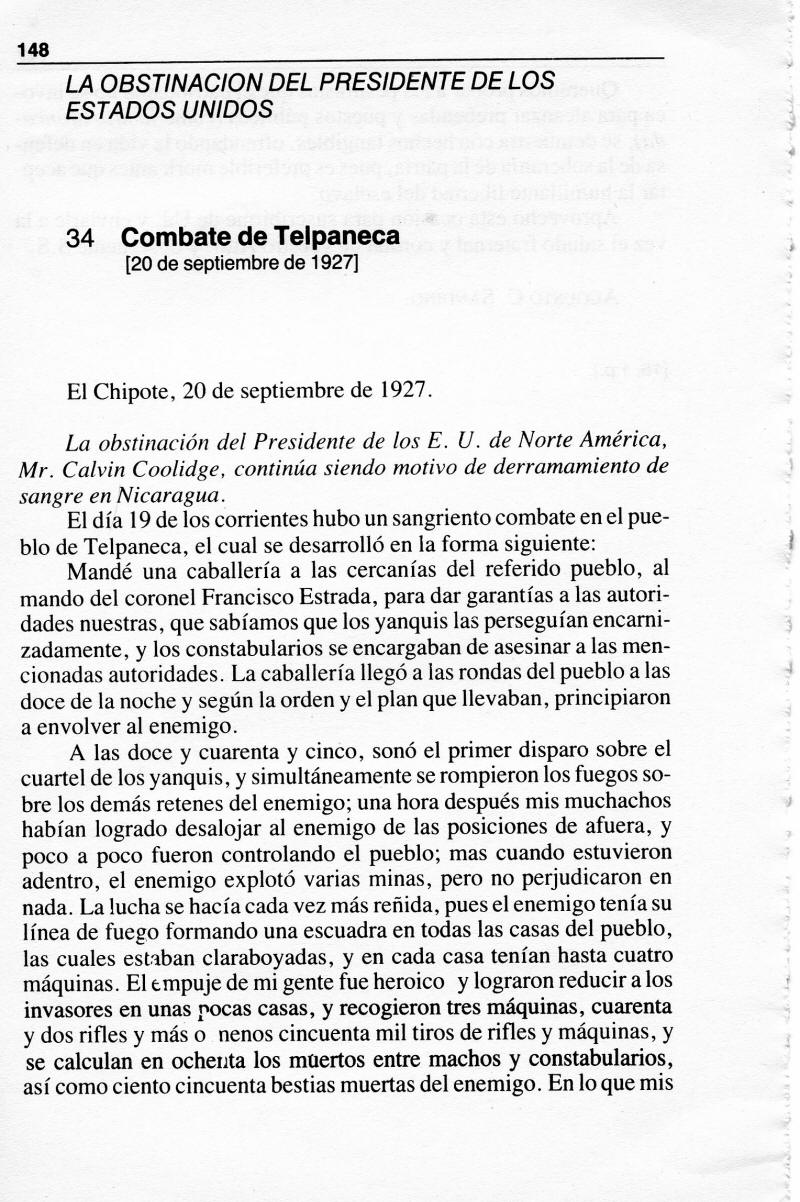
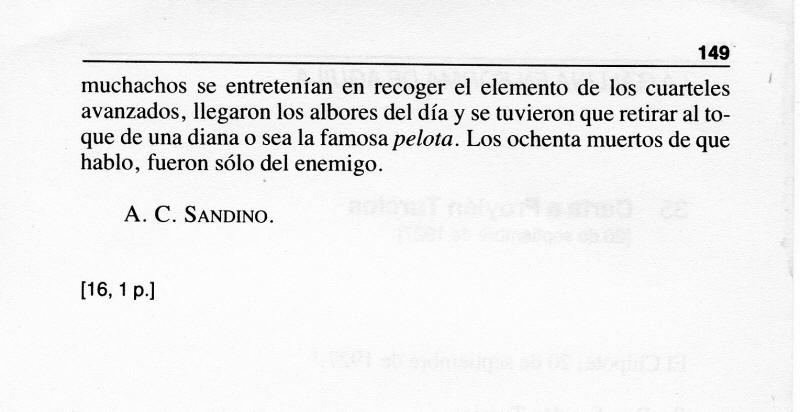
Document Inventory
||
INVENTARIO DE DOCUMENTOS
Fuente: Augusto
C. Sandino, El pensamiento vivo, tomo 1
(Managua: Ed. Nueva Nicaragua, 1984), pág. 148-49.
|
27.09.21.
Ancillary Document No. 2:
Diario
Moderno (Managua),
"Sangriento Combate en Telpaneca"
Document Inventory
||
INVENTARIO DE DOCUMENTOS
27.09.22. ancillary
document no. 3. STATEMENT OF THE
ATTACK ON TELPANECA 21 SEPTEMBER
1927 BY LIEUT. H.S. KEIMLING.
(eN ESPAÑOL)
Note:
This report describes a
follow-up EDSN attack two days
later that lasted a little over
an hour and apparently resulted in no
casualties on either side.
|
T R A N S C R I
P T I O N •
T R A N S C R I P C I Ó
N
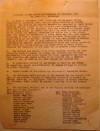 Statement of the attack
on Telpaneca 21
September 1927 Statement of the attack
on Telpaneca 21
September 1927
by Lieut. H.S. Keimling.
1. At 2045
21 September 1927, rifle
and sub-thompson firing
commenced at Telpaneca,
Nic., on a hill slope
occupied by Guardia
Nacional. The
Marines and Guardia
immediately repaired to
their battle stations
and all lights in our
barracks were
extinguished.
Several shots were fired
at the barracks.
Fire was returned at
figures noted to be
moving about. An
attempt was made by
enemy to gain the tower
of the church for
sniping locations but
failed due to our prompt
fire. The enemy
endeavored to force
their way into some
private buildings in
rear of Guardia Barracks
but were frustrated by
the quick action of the
Guardia. Several
of them were routed by
Guardia when an effort
was made to gain
admission into native
houses strategically
located. Enemy
retreated to river and
firing ceased at 2200
which was mostly
sniping. All hands
stood by their battle
stations the remainder
of the night but no
further action occured.
2. The Marines and
Guardia took their
stations orderly and
were instantly ready to
engage the enemy.
All officers and men
were commendably cool
and quiet during the
brief engagement and due
to this condition and
prompt action it is
believed that a similar
attack to the one made
on the 19th instant was
warded off.
3. No casualties
occurred to our forces
or trace to the enemy.
No casualties amonst
non-combatants. No
damage or loss to priave
or public property.
4. Bandit leader
of the attack was
reported as Francisco
Garcia.
5. The following
offer [officers] and men
of the Marines and
Guardia took part in the
attack. Captain
H.S. Keimling, G.N. de N
in command at Guardia
Barracks, Lt. Bellinger,
USMC in charge of marine
quarters. Lt.
Waterman, USMC, second
in command assisting CO
at the command post.
6. The
following enlisted men
of the Guardia Nacional
de Nicaragua took part
in the engagement:
Cpl. Hernandez
Jose A
Pvt. Salamanca
Justo
Huerta Luis
Centeno Alberto
Cheves Alberto
Canales Francisco
Altamirano Juan
Ardon Pedro
Santamaria Miguel
Romero Rafael
Saballos Pedro
Jerez Miguel
Reyes Napoleon
Median Ofilio
Tapia Julio
Dias Felix |
Cpl. Pena
Francisco
Pvt. Morales
Modesto
Centeno Aden
Aguirres Carlos
Arguello Francisco
Cantillo Ernesto
Rodrigues Alejandro
Sanchez Luis
Condega Diego
Cortes Salomon
Zapata Domingo
Zeledon Marcos
Vargas Alfredo
Buitrange Rosemberg
Fonseca Adan
Nosaldy Orlando |
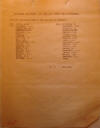 [p.
2] Statement of
attack on Telpaneca 21st
Sept Continued: [p.
2] Statement of
attack on Telpaneca 21st
Sept Continued:
Marines participating in
the attack as follows:
Sgt. Eaden, Alva
Pvt. Albright,
C.M.
Whitehead, H.A.
Krummel, L.A.
Elcher, W.
Roselue,
Voit, F. B.
Fox, C.M.
Gratehouse, L.V.
Dzurva J.T.
Heater, C.M.
Dunn, V.E.
Willis, L.L.
Rhodes, J.C.
Mendell, M.D.
March, H.W.
Nichols, V.L. |
Cpl. Carlson, F.
Thompson, G.F.
Crowser, W.
Howard, F.B.
Allen, R.L.
Harris, T.W.
Martin, W.E.
Lynn, W.W.
Kincanor, J.W.
Murphy, O.C.
Davis, T.K.
Foote, F.
Handzlik, L.C.
Irwin, R.H.
Macon, D.H.
Machura, J.J.
Link. |
(s) H. S. KEIMLING.
|
Document Inventory
||
INVENTARIO DE DOCUMENTOS
27.09.22. DOC AUXILIAR
NÚM. 3: DECLARACIÓN DEL
ATAQUE DE TELPANECA 21 DE
SEPTIEMBRE DE 1927 POR tNT. H.S. KEIMLING.
Nota:
Este informe describe un ataque
siguente dos días después, de 8.45 PM hasta 10 PM el 21
de septiembre.
|
T R A N S C R I
P T I O N •
T R A N S C R I P C I Ó
N
DECLARACIÓN DEL ATAQUE
EN TELPANECA DEL 21 DE
SEPTIEMBRE DE 1927
Por el Teniente H.S.
Keimling.
1. A las 2045 del 21 de
septiembre de 1927,
disparos de rifle y
sub-thompson comenzaron
en Telpaneca, Nic., en
una pendiente de la
colina ocupada por la
Guardia Nacional. Los
Marines y la Guardia se
desplegaron
inmediatamente a sus
puestos de batalla y
todas las luces en
nuestros cuarteles se
extinguieron. Se
realizaron varios
disparos contra los
cuarteles. El fuego fue
devuelto a las figuras
que se notaban en
movimiento. Un intento
fue hecho por parte del
enemigo en tomarse la
torre de la iglesia para
ubicación de sus
francotiradores pero
falló debido a nuestro
pronto fuego. El enemigo
se esforzó por entrar en
algunos edificios
privados en la parte
trasera de los cuarteles
de la Guardia, pero
fueron frustrados por la
acción rápida de la
Guardia. Varios de ellos
fueron interceptados por
la Guardia cuando un
esfuerzo se hizo para
ganar admisión en las
casas nativas situadas
en lugares estratégicos.
El enemigo se retiró
hacia el río y el fuego
cesó a las 22.00 horas,
el cual fue en su
mayoría de
francotirador. Todas las
manos permanecieron
junto a sus estaciones
de batalla el resto de
la noche, pero no
ocurrió ninguna otra
acción.
2. Los Marines y la
Guardia tomaron sus
puestos ordenadamente y
estaban al instante
prestos para combatir al
enemigo. Todos los
oficiales y todos los
oficiales y hombres
estuvieron
reconocidamente
tranquilos y silenciosos
durante el breve combate
y debido a esta
condición y pronta
acción, se consideró que
un ataque similar al que
fue hecho el 19 fue
mantenido a raya.
3. No ocurrieron bajas
de nuestras fuerzas ni
rastros de enemigo. No
hay víctimas entre los
no combatientes. Ningún
daño o pérdida a la
propiedad privada o del
público.
4. El líder de los
bandidos del ataque fue
reportado como Francisco
García.
5. La siguiente
oficiales y hombres de
los Marines y la Guardia
participaron en el
ataque. Capitán H.S.
Keimling, G.N. de N
(Nicaragua) en el mando
de los cuarteles de la
Guardia, el teniente
Bellinger, USMC a cargo
de los cuartos marinos.
El teniente Waterman,
USMC, segundo al mando
que asiste al CO en el
puesto de mando.
6. Participaron en el
combate los siguientes
enlistados de la Guardia
Nacional de Nicaragua:
Cpl. Hernandez
Jose A
Pvt. Salamanca
Justo
Huerta Luis
Centeno Alberto
Cheves Alberto
Canales Francisco
Altamirano Juan
Ardon Pedro
Santamaria Miguel
Romero Rafael
Saballos Pedro
Jerez Miguel
Reyes Napoleon
Median Ofilio
Tapia Julio
Dias Felix |
Cpl. Pena
Francisco
Pvt. Morales
Modesto
Centeno Aden
Aguirres Carlos
Arguello Francisco
Cantillo Ernesto
Rodrigues Alejandro
Sanchez Luis
Condega Diego
Cortes Salomon
Zapata Domingo
Zeledon Marcos
Vargas Alfredo
Buitrange Rosemberg
Fonseca Adan
Nosaldy Orlando |
[pág. 2] Declaración del
ataque de Telpaneca 21
de septiembre
Continuación:
Marines que participan
en el ataque de la
siguiente manera:
Sgt. Eaden, Alva
Pvt. Albright,
C.M.
Whitehead, H.A.
Krummel, L.A.
Elcher, W.
Roselue,
Voit, F. B.
Fox, C.M.
Gratehouse, L.V.
Dzurva J.T.
Heater, C.M.
Dunn, V.E.
Willis, L.L.
Rhodes, J.C.
Mendell, M.D.
March, H.W.
Nichols, V.L. |
Cpl. Carlson, F.
Thompson, G.F.
Crowser, W.
Howard, F.B.
Allen, R.L.
Harris, T.W.
Martin, W.E.
Lynn, W.W.
Kincanor, J.W.
Murphy, O.C.
Davis, T.K.
Foote, F.
Handzlik, L.C.
Irwin, R.H.
Macon, D.H.
Machura, J.J.
Link. |
(S) H. S. KEIMLING.
|
Document Inventory
||
INVENTARIO DE DOCUMENTOS
27.09.19. ANCILLARY
DOC 4: FRAGMENT OF AN
ANONYMOUS DIARY OF A SANDINISTA
SOLDIER WHO TOOK PART IN THE
ATTACK
(EN ESPAÑOL)
Note:
This English-language translated
fragment of an anonymous diary
kept by a Sandinista soldier who
took part in the attack on
Telpaneca on 19 September 1927
was seized by Marine Corps
Captain Maurice Holmes in early
April 1928, during a complex
series of assaults on the
Sandinista strongholds in the
area around El Chipote (see
PC-DOCS > 1928: 2 > 28.04.08
Holmes, or
www.sandinorebellion.com/PCDocs/1928a/PC280408-Holmes.html
). English translation
only. The original letters
have not been found.
Holmes's report of his seizure
of this and other documents in
early April 1928 is included as
an addendum to this diary
fragment.
|
T R A N S C R I
P T I O N •
T R A N S C R I P C I Ó
N
 I
enlisted in the ranks of
General Carlos Salgado
on the 28th of August
1927. We left the camp
at Zapote the 30th of
the present. We reached
Telpaneca on the 31st of
same. The 1st of
September a patrol of
the Salgado forces left
and met the enemy and
there was a battle at
the point called
Carbonal. The 2nd there
was another battle at
the point Apamiguel with
the constabulary and the
Machos where four
Yankees and soldiers of
the enemies of the
country died, and there
also died three Liberals
and two wounded of the
patrol commanded by
Major Lobo. We entered
San Juan de Segovia the
3rd of September 1927.
We left San Juan the
15th. We reached a point
called Zapotillal, and
we left the 8th of
September and arrived at
Santa Ana on the 7th of
September. General
Salgado had an interview
with General Sandino.
The 9th we went to
Chipote divided in three
columns. The 11th the
cavalry of 100 men went
out at the command of
Colonels Sanchez and
Colindres to fight the
enemy at the town of
Telpaneca. The 13th the
larger force left for
Telpaneca to help in the
same attack. I
enlisted in the ranks of
General Carlos Salgado
on the 28th of August
1927. We left the camp
at Zapote the 30th of
the present. We reached
Telpaneca on the 31st of
same. The 1st of
September a patrol of
the Salgado forces left
and met the enemy and
there was a battle at
the point called
Carbonal. The 2nd there
was another battle at
the point Apamiguel with
the constabulary and the
Machos where four
Yankees and soldiers of
the enemies of the
country died, and there
also died three Liberals
and two wounded of the
patrol commanded by
Major Lobo. We entered
San Juan de Segovia the
3rd of September 1927.
We left San Juan the
15th. We reached a point
called Zapotillal, and
we left the 8th of
September and arrived at
Santa Ana on the 7th of
September. General
Salgado had an interview
with General Sandino.
The 9th we went to
Chipote divided in three
columns. The 11th the
cavalry of 100 men went
out at the command of
Colonels Sanchez and
Colindres to fight the
enemy at the town of
Telpaneca. The 13th the
larger force left for
Telpaneca to help in the
same attack.
Source:
Record Group 127, Entry
43A, Box 29, U.S.
National Archives.
Addendum:
Report of Capt. Maurice
Holmes on the seizure of
this and other EDSN
documents in early April
1928:
From: CO 52nd
Company, GUIGUILI.
April 6, 1928.
To:
AREA COMMANDER OCOTAL
1106 At 1045 April 5,
fired on three men
fleeing into bush from
house, one fleeing into
bush from house, one
seen to bear firearm.
Wounded one, all
escaped. Found cached in
bush around house: 1
shotgun with powder and
ball, 11 fighting
machetes, several axes,
leg irons for pole
climbing, saddle with
Sandino colors in bands,
quantity of native
clothing and blankets,
two houses contiguous to
caches had quantity of
beans, corn, and
bananas.
1530 Man found spying
our movements, following
in canoe on Cua River in
direction of Cua. 2nd
Lt. Norman and squad
attempted capture.
Native fled, squad fired
and pursued. Native fled
through house in which
were found muzzle
loading carbine, powder
and ball, hat with
Sandino colors.
0215 April 6. Cleared
camp at 0600 arrived
Guiguili. No bandits
present. No sign bandit
activity. House of
Eduardo Palma vacant but
contained at least 1200
pounds of beans. (Dumped
beans in river) Palma
alleged fleeing from
bandits.
Am forwarding a number
of letters which
apparently contain
useful information.
Holmes 1300
---------------------------------------------------
From: CO. 52nd
Company Guiguili.
April 8, 1928.
To: AREA
COMMANDER OCOTAL
1108 While enroute here
from Guiguili, at 1345,
point fired on party of
3 natives, one of whom
wore khaki and carried a
rifle, all mounted.
Natives fled, one
quitting a gray mule,
brand U.S. boot number
245. On mule was native
saddle carrying pair of
regulation (our) saddle
bags in which were 7
cartridges, .50 caliber,
Krag (RA 17),
One 11 Field Message
Book, U.S.M.C. Condiment
can contained notes
only, in number, 7
signers, including
Coronado Maradiaga.
Also found muzzle
loading shotgun in same
house. Have been
occupying house of
Eduardo Palma for which
section is named
Guiguili. Found there on
7th. additional caches
of 500 pounds of beans
and smaller articles
bringing total there
approximately 2100
pounds. Also found full
bandolier Krag
ammunition. Withheld
burning house to keep as
quarters stop. Holmes
1700. Strength patrol
Capts. Holmes and
Phipps, 40 enlisted one
(1) Navy. 1100.
Source:
See
www.sandinorebellion.com/PCDocs/1928a/PC280408-Holmes.html
|
Document Inventory
||
INVENTARIO DE DOCUMENTOS
27.09.19. DOC
AUXILIAR NÚM. 4: FRAGMENTO
DE UN DIARIO ANÓNIMO DE UN
SOLDADO SANDINISTA QUE TOMÓ
PARTE EN EL ATAQUE
|
T R A N S C R I
P T I O N •
T R A N S C R I P C I Ó
N
Me enlisté en las filas
del General Carlos
Salgado el 28 de agosto
de 1927. Salimos del
campamento de Zapote el
día 30 del presente.
Llegamos a Telpaneca el
día 31 de la misma. El 1
de septiembre una
patrulla de las fuerzas
de Salgado salió y se
encontró con el enemigo
y hubo una batalla en el
punto llamado Carbonal.
El dos de Septiembre
hubo otra batalla en el
punto Apamiguel con la
Guardia y los Machos,
donde murieron cuatro
yanquis y los soldados
enemigos del país, y
también murieron tres
liberales y dos heridos
de la patrulla comandada
por el mayor Lobo.
Ingresamos a San Juan de
Segovia el 3 de
septiembre de 1927.
Salimos de San Juan el
día 15. Llegamos a un
punto llamado
Zapotillal, y salimos el
8 de septiembre y
llegamos a Santa Ana el
7 de septiembre. El
general Salgado tuvo una
entrevista con el
General Sandino. El día
9 fuimos al Chipote
dividido en tres
columnas. El 11, la
caballería de 100
hombres salió al mando
de los coroneles Sánchez
y Colindres para
combatir al enemigo en
la ciudad de Telpaneca.
El 13, la fuerza mayor
se fue para Telpaneca
para ayudar en el mismo
ataque.
Fuente: Registro del
Grupo 127, Entrada 43A,
Recuadro 29, Archivos
Nacionales de los
Estados Unidos.
ADDENDUM:
INFORME DEL CAPITÁN
MAURICE HOLMES SOBRE LA
INCAUTACIÓN DE ESTE Y
OTROS DOCUMENTOS EDSN A
PRINCIPIOS DE ABRIL DE
1928:
De: CO 52ava Compañía,
GUIGUILI. 6 de abril de
1928.
A: COMANDANTE DE ÁREA
OCOTAL
1106 A las 1045 del 5 de
abril, dispararon contra
tres hombres que huían
de los matorrales desde
una casa, uno huía de la
casa a un arbusto, uno
considerado que portaba
arma de fuego. Herido
uno, todos escaparon.
Encontrado oculto en los
arbustos alrededor de
casa: 1 escopeta con
pólvora y perdigones, 11
machetes de combate,
varios hachas, anclas de
hierro para escalar,
sillas de montar con
bandas con los colores
de Sandino, cantidad de
ropa nativa y mantas,
dos casas contiguas a
lugar de escondite
tenían cantidad de
frijoles , El maíz y los
plátanos.
1530 Hombre encontrado
espiando nuestros
movimientos,
siguiendonos en canoa en
el río Cua en dirección
al Cua. El segundo
teniente Norman y el
escuadrón intentaron
capturarlo. Nativo huyó,
el escuadrón disparo y
persiguió. Nativo huyó a
través de la casa en la
que se encontraron
carabina amordazada
cargada, pólvora y
perdigones, y sombrero
con colores Sandino.
0215 6 de abril.
Campamento despejado a
las 06.00 horas llegada
a Guiguili. No hay
bandidos presentes. No
hay actividad de
bandidos. Casa de
Eduardo Palma vacía pero
contenía por lo menos
1200 libras de frijoles.
(Vertidos sobre en el
río) Palma alegó huir de
los bandidos. Estoy
enviando una serie de
cartas que aparentemente
contienen información
útil. Holmes 1300
De: CO. 52ª Compañía
Guiguili. 8 de abril de
1928.
A: COMANDANTE DE ÁREA
OCOTAL
1108 Mientras nos
encaminamos desde aquí
de Guiguili, a las 1345,
apuntamos fuego a un
grupo de 3 nativos, uno
de los cuales vestia
khaki y portaba un
rifle, todos montados.
Los nativos huyeron, uno
de ellos dejando una
mula gris, marcada
estadounidense en la
bota con el número 245.
En la mula estaba
ensillada nativamente
portando un par de
regulación (nuestras)
bolsas de montar en la
que habían 7 cartuchos,
50 calibre, Krag (RA 17)
, una 11 cuaderno de
mensajes de campo,
Condimento de USMC que
sólo puede contener
notas, en número, 7
firmantes, incluyendo
Coronado Maradiaga.
También se encuentró
carabinas cargandas y
escopeta en la misma
casa. Habiendo ocupando
la casa de Eduardo Palma
para la cual dicha
sección se llamó
Guiguili. Encontrado
allí el 7. Adicionales
almacenamientos de 500
libras de frijoles y
artículos más pequeños,
con un total de
aproximadamente 2100
libras. También se
encontró munición
completa Krag de
bandolera. La casa
retenida quemada para
tenerla como punto a los
escuadrones. Holmes
1700. Patrulla de fuerza
de Capitán Holmes y
Phipps, 40 enlistados
una (1) Marina. 1100.
|
Document Inventory
||
INVENTARIO DE DOCUMENTOS
27.09.17.
ANCILLARY DOC 5:
INTELLIGENCE REPORT OF THE
MARINES-GUARDIA BEFORE THE
ATTACK
(EN
ESPAÑOL)
Note:
This excerpt of an intelligence
report of Sept. 17, 1927 is
apparently based on the reports
of spies, who "reliably
reported" that Gen. Carlos
Salgado joined Sandino at El
Chipote around Sept. 12 ("about
five days ago" in a report dated
Sept. 17). According to
the anonymous diary quoted
above, Salgado's forces joined
Sandino at El Chipote on Sept. 9
— a difference of only three
days. Also worth noting is
that the EDSN was formally
founded on Sept. 2. My
best read of these fragments is
that Salgado and his troops
joined Sandino at El Chipote a
week or so after the founding of
the EDSN, and together Salgado
and Sandino developed a plan for
Salgado and his forces to attack
the Marine-Guardia garrison at
Telpaneca later in September.
|
T R A N S C R I
P T I O N •
T R A N S C R I P C I Ó
N
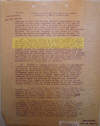 It
is my belief, and that
of my officers, that
Sandino is actively
present in Chipote.
Salgado is reliably
reported to have joined
there with 200 men about
five days ago. Prior to
that time he is reported
to have had but 100 men
under his personal
control. It
is my belief, and that
of my officers, that
Sandino is actively
present in Chipote.
Salgado is reliably
reported to have joined
there with 200 men about
five days ago. Prior to
that time he is reported
to have had but 100 men
under his personal
control.
Source:
First Lt. Glenn E.
Hayes, Commanding
Officer, Ocotal,
Intelligence report for
the week ending
September 17, 1927, p.
2, NA127/43A/3.
|
Document Inventory
||
INVENTARIO DE DOCUMENTOS
27.09.17. DOCS
AUXILIARES NÚM. 5:
INFORME DE INTELIGENCIA DE LOS
MARINES-GUARDIA ANTES DEL
ATAQUE
Nota:
Este es un extracto de un
informe de inteligencia del 17
de septiembre de 1927 y se basa
aparentemente en informes de los
espías, que "informaron
fiablemente" que el General
Carlos Salgado se unió a Sandino
en El Chipote cerca del 12 de
septiembre ("hace unos cinco
días" en un informe fechado el
17 de septiembre). Según el
diario anónimo citado
anteriormente, las fuerzas de
Salgado se unieron a Sandino en
El Chipote el 9 de septiembre,
una diferencia de sólo tres
días. También vale la pena
destacar que el EDSN fue
formalmente fundado el 2 de
septiembre. Lo mas destacado de
estos fragmentos es que Salgado
y sus tropas se unieron a
Sandino en El Chipote una semana
después de la fundación del EDSN
y juntos Salgado y Sandino
desarrollaron un plan para que
Salgado y sus fuerzas atacaran
la guarnición de Guardia
Marítima-Guardia en Telpaneca
más tarde en septiembre.
|
T R A N S C R I
P T I O N •
T R A N S C R I P C I Ó
N
Es mi opinión, y la de
mis oficiales, que
Sandino esté presente
activamente en Chipote.
Se ha informado que
Salgado se le ha unido
con 200 hombres hace
unos cinco días. Antes
de ese tiempo se informa
que había tenido sólo
100 hombres bajo su
control personal.
Fuente:
First Lt. Glenn E.
Hayes, Commanding
Officer, Ocotal,
Intelligence report for
the week ending
September 17, 1927, p.
2, NA127/43A/3.
|
Document Inventory
||
INVENTARIO DE DOCUMENTOS
2017 & AFTER:
READERS' COMMENTARIES ON THESE
EVENTS
||
COMENTARIOS DE LECTORES SOBRE
ESTOS EVENTOS
Document Inventory
||
INVENTARIO DE DOCUMENTOS
|
